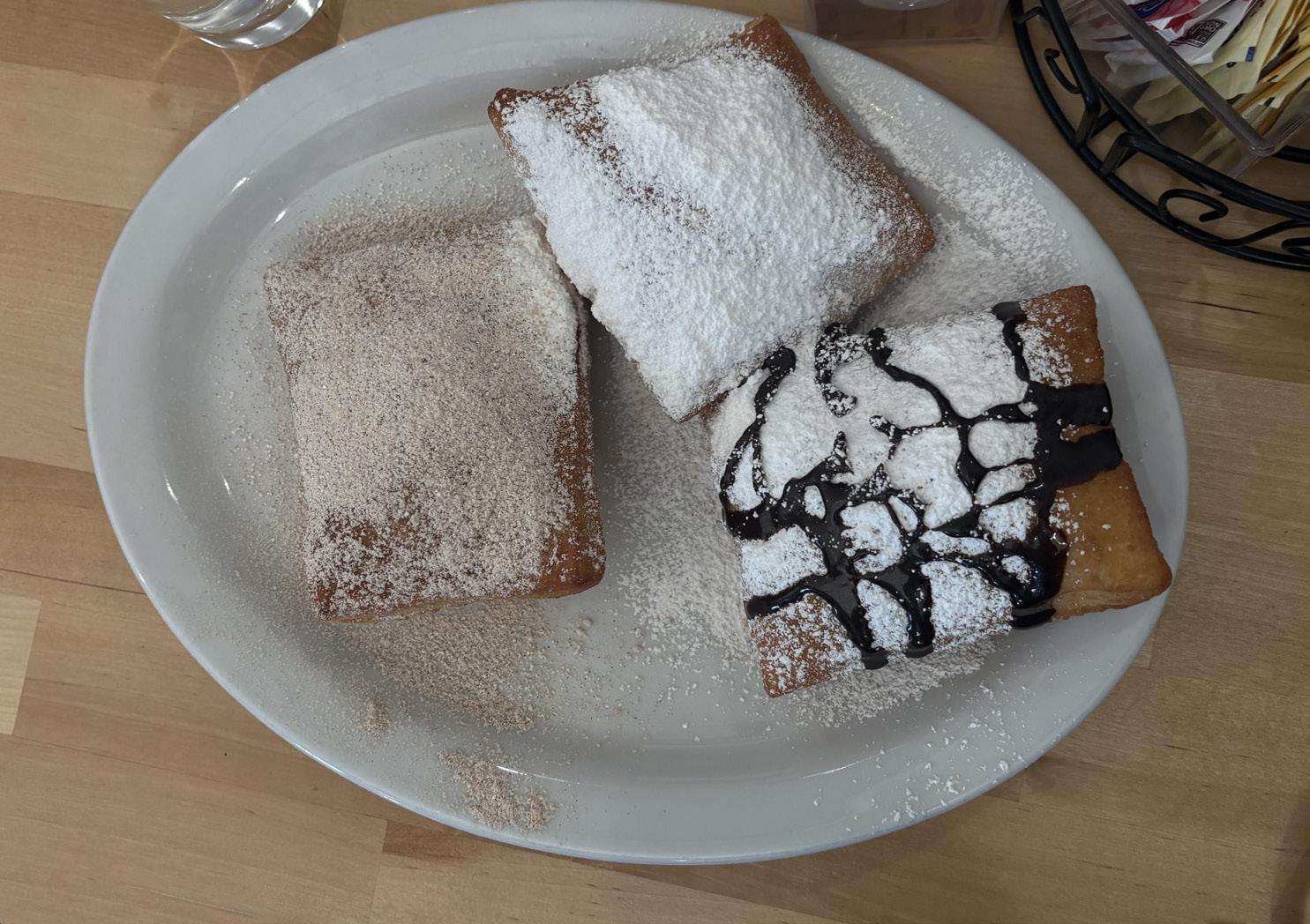

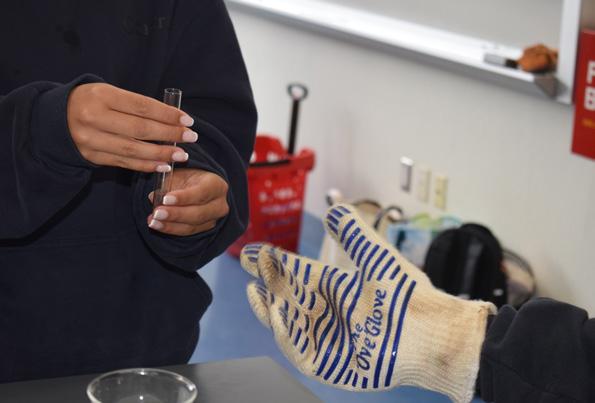








By Daniella Lainez ’26
On July 15, religion teacher, track and cross country coach, and beloved member of the Riordan community Nicholas Pellegrino, better known as Mr. P, was brutally attacked and robbed while traveling by train during his summer vacation from Milan to Florence, Italy.
On his way to visit family and friends, Pellegrino was approached by two men within the first 10 minutes of what was supposed to be a three hour train ride.
“I was sitting there with my head down. I could feel that I had eyes on me, and I kind of suspected they were going to do something bad,” Pellegrino recalled. “These two men, who looked about 22, attacked me.”
He was stabbed in the neck with a pocketknife, left with blood actively gushing from his neck and stripped of all his belongings aside from his phone and wallet that were left in his pocket.
Lying alone, exposed, and completely vulnerable against walls of the train, Pellegrino was
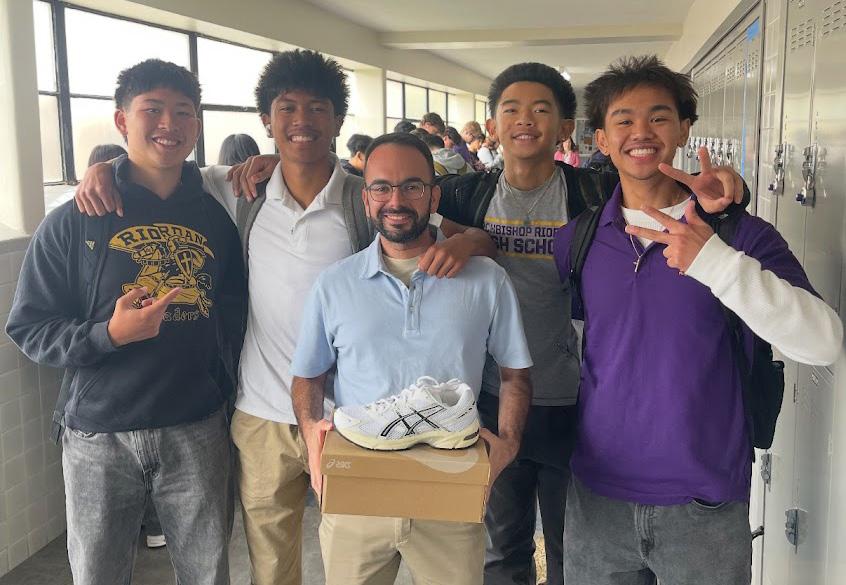
Seniors Diego Merida, Aidan Alday, Isaiah Sanchez, and Avery Agbunag bought teacher Nicholas Pellegrino a new pair of shoes to replace ones that were damaged on July 15, when he was attacked and robbed in Milan, Italy.
eventually helped by a 16-yearold Italian passerby who called for emergency help. Paramedics arrived within 15 minutes, rushing him to a nearby hospital.
“I was really isolated, and it was a very lonely time,” he said. “The scariest moment for me was the waiting.”
At the hospital, the doctors
immediately performed a CAT scan. Despite the heavy bleeding, Pellegrino’s external jugular vein was only partially nicked and not completely severed.
“God forbid if it was severed, I would not be here right now. It’s a miracle when you think about it,” he said.
Pellegrino spent multiple days
in recovery at an Italian hospital before he was cleared to leave.
Luckily, he had many relatives in the country who supported him, and as a fluent Italian speaker, he faced zero language barrier during his stay. He was even able to testify against his attackers and assure justice was served.
“Speaking Italian allowed me to give my testimony in court for these two people, and we got them convicted with the help of the Italian police,” Pellegrino said. His cousins drove two hours from Genova, Italy to visit him in the hospital, and a college friend, Gianpaolo Caprino, cared for him during the five day waiting period after leaving the hospital before his flight back to the United States.
After returning home to New York—where Pellegrino is originally from—he received towering support from friends and family.
Please see “Teacher survives near-death encounter” on page 7
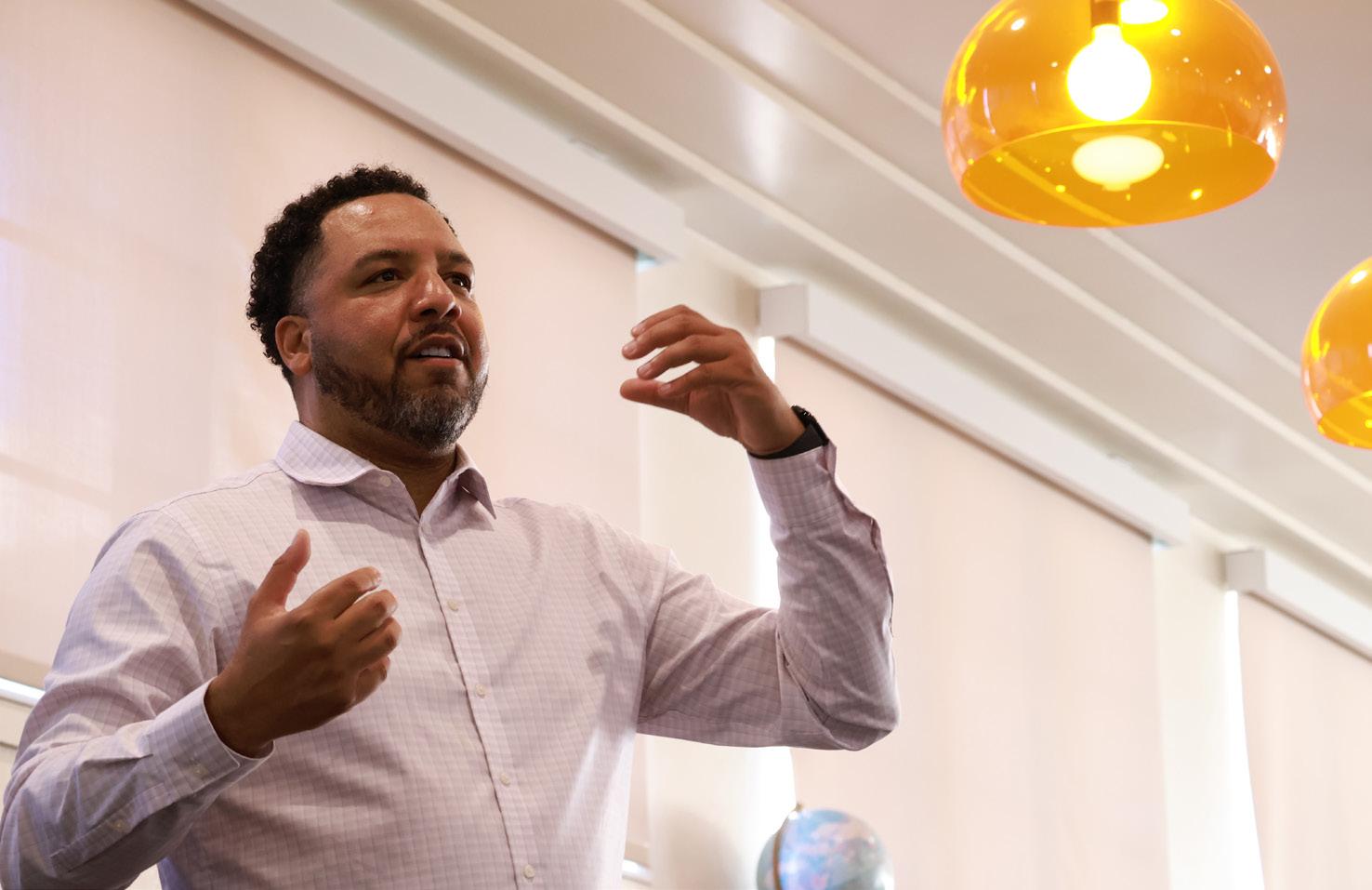
By Ciarra Mangibuyat ’27
On Saturday, Sept. 27, Archbishop Riordan High School welcomed nearly 500 aspiring journalism students and advisers from 44 different schools as it hosted the 2025 NorCal Media Day.
Riordan was the first San Francisco school to host NorCal Media Day, as it was previously at Palo Alto High School.
The event brought together students from across Northern California who share a love for journalism and the media to partake in several learning sessions focused on media: newspaper, yearbook, photography, podcasting, and broadcasting, which were led by
teachers, pros, and students. The day began with an introduction in Lindland Theatre by Riordan journalism adviser Susan Sutton, MJE, JEANC President Julia Satterthwaite, MJE of Monta Vista High School, 95.7 The Game’s host Joe Shasky ’01, and NBC Sports Bay Area’s Golden State Warriors Pre/ Postgame Live host Bonta Hill. They presented the schedule for the day and encouraged the excited students to learn before sending them off to the sessions.
Please see “Riordan hosts NorCal Media Day” on page 7
By Keira Wallace ’26
Ever since the decision to go coed at the beginning of the 2020-21 school year, Riordan has become one of the most rapidly growing schools in the Bay Area. In areas like athletics, academics, and general enrollment, Riordan has soared above its competitors and grown quite swiftly.
Riordan has become one of the most rapidly growing schools in the Bay Area.
However, such rapid growth didn’t come without challenges.
Before Riordan decided to go coed, the total enrollment was just 660 students. While this number was on the lower side, it was manageable.
Gradually, due to our increasing student population, all of our students can no longer fit in the theatre, which used to be possible three years ago. In addition, our gym can at least fit all of our students; however, not comfortably.
This dynamic led to the reorganization of many school events such as rallies, house games, dances, and more.
In areas like athletics, academics, and general enrollment, Riordan has soared above its competitors and grown quite swiftly.
Riordan’s increased enrollment has also led to some significant changes to our schedule. The bell schedule, which students have mixed opinions on, requires upperclassmen and underclassmen to arrive and exit school at different times.
This decision, likely a result of crowding during pickup and drop off, has become an inconvenience for many clubs and sports. Some students have grown to like the new schedule, but others have a
Mission Statement for the Archbishop Riordan High School Newspaper
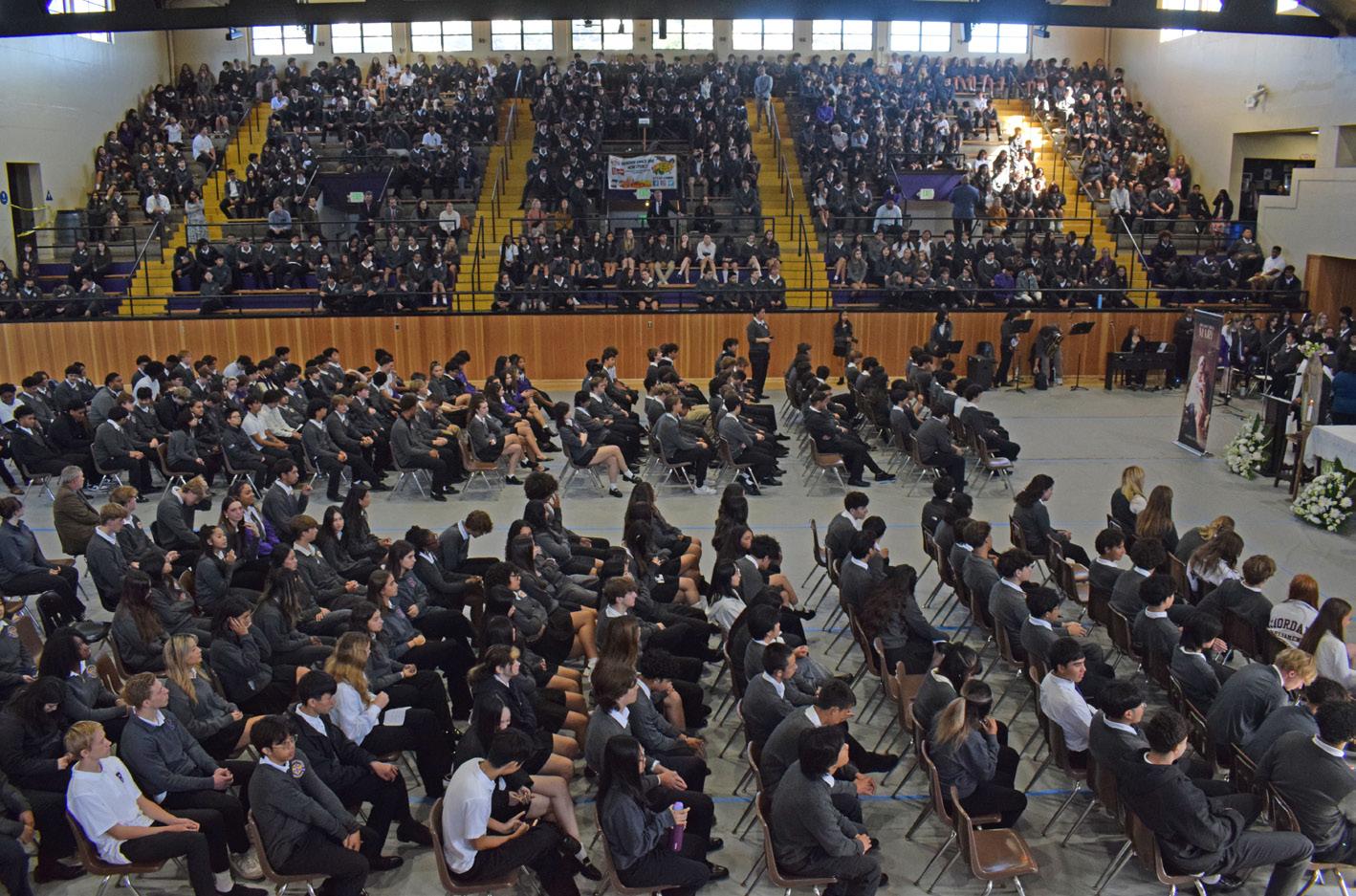
negative attitude towards it.
As Riordan sees more and more applicants each year, it is increasingly difficult to earn a seat here. However, making Riordan a more competitive school seems like the simplest way to solve this problem.
New decisions are being made to improve our school each year, including the student park, more
The mission of The Crusader is to inform, educate and entertain the readers—students, teachers, parents, members of the community—about issues that affect the students as well as citizens of San Francisco and the nation. We hope to instill a sense of understanding, responsibility, and curiosity in our readers that results in an eagerness to learn more about their peers and the world around them.


175 Frida Kahlo Way San Francisco, CA 94112 RCrusaderNews.com RCrusaderNews@riordanhs.org
Editor-in-Chief
Daniella Lainez ’26
Managing Editor
Ishaan Gupta ’26
Opinion Editor
Keira Wallace ’26
Campus News Editors
Emmanuelle Ng ’26
Hailey Ferrer ’26
Local & State News Editor
Erin Quan ’26
National & World News Editor
Rachel Gerke ’27
Boys Sports Editor
Miles Witte ’27
Girls Sports Editor
Emilia Ross ’26
Sports Features Editor
Isaiah Sanchez ’26
Arts & Entertainment Editor
Ciarra Mangibuyat ’27
Environment Editor
Vincy Huang ’27
Religion Editor
Logan Dee ’26
Health Editor
Isabelle Abad ’26
Science Editor
Joshua Lee ’26
Business & Technology Editor
Isabella Thumas ’26
Features Editor
Lorelai Keating-Curran ’27
Food Review Editor
Loghan Hwang ’27
Photo Editors
Loghan Hwang ’27
Ethan Ly ’26
Copy Editors
Aarav Agrawal ’28
Rose Baik ’26
Chloe DeCastro ’26
Hazel Nagata-Rampata ’26
Graphic Artists
Ivonna Tan ’29, Lindsey Yeh ’29
classes, and new faculty, but it’s worth considering that Riordan accept fewer students for the upcoming underclassmen classes.
With this simple change, we could go back to our old schedule without all the traffic. We could have more class space and smaller class sizes, and enough room to comfortably accommodate all students.

Reporters and Photographers
Alyssa Abaunza ’26
Avery Agbunag ’26
Adriana Alvarado ’26
Julian Amann ’26
Katherine Baez Orellana ’26
Robert Bennett ’27
Jonah Berg ’28
Kaia Burris ’27
Miguel Cardenas ’27
Sasha Feliciana-Chan ’26
Mikayla Cheng ’26
Arim Choi ’26
Lucia Federico ’29
E’moni Ferdinand ’26
Delaney Flanagan ’26
Jordyn Flores ’27
Derrill Floyd ’27
Isabel Fonseca ’27
Brock Garcia ’26
Lainey Gerke ’28
Henry Godwin ’27
Jude Kopping ’27
Alessandra Leon ’26
Ashley Li ’27
Lily Lincoln ’28
Grace Longaway ’27
Ivana Maldonado ’26
Exchange Editor
Ashling Greene ’26
Reporters and Photographers
Rhianna Mallory ’26
Isaac Martin ’26
Miki Maloney ’26
Isaiah Mateo ’26
Tyce Morrison ’27
Elliott Ng ’28
Matthew Nicolas ’29
Collin Noguera ’27
Sara Noguera ’27
Martin Novoa ’26
Jared Pangalangan ’28
Aliyah Pasion ’26
Sofia Peña ’26
Elise Robinson ’28
Catherine Rold ’27
Natalia Sanchez ’26
Sofia Sarracino ’27
William Saunders ’26
Aiden Sommerfield ’28
Logan Tuman ’26
Oscar Wadsworth ’26
Elizabeth Walsh ’26
Crystal Wei ’26
Luna Weng ’28
Oliver White ’29
Bernice Yeung ’28
Charlottie Yip ’26
Adviser
Susan Sutton, MJE
Letters to the Editor
Letters to the editors will be accepted with the same deadlines as ads. These letters may come from students, staff, parents, board members, or other members of the community. The Crusader reserves the right to edit the letter for grammatical and spelling errors, as well as length, but not content unless it includes foul language, plagiarized material, or libelous content. If the claims or assertions are incorrect, The Crusader reserves the right to refuse publication of the letter.
By Isabel Fonseca ’27
One in 100 people living in San Francisco are without a home (SF.gov). While San Francisco is home to numerous of the elite of Silicon Valley and the tech world, it also harbors one of the largest populations of unsheltered homeless compared to the city population in America.
Homelessness is not a new phenomenon in San Francisco. In fact, the last seven mayors have all made efforts to address the issue. However, historically, they have been mostly ineffective as the issue persists into 2025.
The issue stems from a combination of major cuts of funding from the government, increasing numbers of Vietnam vets in need of aid, increasing price of homes, and a spike in unemployment due to a national recession in the late 1970s through the early 80s, which created a perfect combination resulting in a sudden surge of homeless in the United States, and particularly San Francisco.
In 2018, the city of San Francisco spent $300 million on homeless prevention, yet the homeless population failed to subdue (KQED).
So, how does a San Francisco mayor effectively aid the homeless

“Breaking the Cycle” measure created outreach teams and stabilization centers and new methods for connecting those in need of treatment with help. Also, it increased the recovery bed capacity to help people find housing.
crisis? By creating meticulous pro-help legislation that hits the problem at its core: the high cost of living in San Francisco and economic hardship.
In August, Daniel Lurie’s administration launched three recovery-focused temporary housing programs. These serve those in need in their journey from substance abuse and homelessness to long-term life stability.
This is one of the numerous measures of Lurie’s “Breaking the Cycle,” which has created sectionbased street outreach teams and stabilization centers and new methods for connecting those in need of treatment as well as increased the recovery and aid bed capacity, What makes this type of aid effective is that it supports those who are actively trying to leave homelessness and improve their conditions. In addition, the
comprehensive nature ensures all aspects of the needy are met. According to the SF Department of Public Health Daniel Thai, “By pairing housing with onsite treatment and supportive services we are breaking the cycle and setting a new standard for how cities address homelessness and addiction” (SF.gov).
The effects of these novel measures are most definitely felt in the city. According to Mission Local, since 2020, the number of homeless has decreased by approximately 87 percent since its peak of 1,208 tent-adjacent structures in April 2020, compared to the current one 165 in June 2025.
Lurie said, “[Breaking the Cycle] will break the cycle of homelessness, addiction, and government failure by transforming our homelessness and behavioral health response. My administration is beginning a new era of accountability and will deliver outcomes that get people off the street and into stability” (SF.gov).
While homelessness is still an ongoing problem in San Francisco, new policies with Mayor Lurie are affecting true, and very likely, lasting change in the issue.

By
With the new school year comes new changes to Riordan, with one major change being in the cafeteria.
In the midst of the swarms of people in the cafeteria during break or lunch, a new line system awaits the hungry students. But
it seems to be more time consuming rather than practical.
In previous school years, the lunch line ran through the center of the cafeteria, with all three exits not being designated for leaving or entering the cafeteria. But now, the two side doors
and lunch lines that snake around the sides of the cafeteria are designated for entering the cafeteria, with the middle door and line being for students to exit out of the cafeteria.
The lines, according to fellow students, seem to be more of a disturbance rather than a positive addition to the cafeteria.
Rhianna Mallory ’26 commented, “It takes longer to get inside especially because at the start of lunch nobody is using the exit to actually exit. It would make more sense to go back to how it was before without any door monitoring.”
Though the new designated doors and lines allow for an organized environment in the cafeteria, when it comes down to hungry students at the start of lunch, efficiency and speed seem to be the main priority.
In comparison to last year’s organization of the cafeteria, Mallory commented that “it takes a lot longer to actually get inside the cafe in comparison to before.”
The lines themselves funnel into the center of the front of the cafeteria, creating a packed mob of students trying to scramble to get their food or trying to escape the swarm to get to the checkout line.
The checkout line also seems to be a similar issue, with the
“The biggest issue I find with the new system is trying to check out because the line is so congested, especially during break.
-Marcus
Appleby ’26
packed food line creating a busy and crowded area.
Marcus Appleby ’26 said, “The biggest issue I find with the new system is trying to check out because the line is so congested, especially during break.”
But with this new organization of the lines, lunch line monitor, Daniel Saelee ’26, complimented that the lines are, “more controlled, less chaotic.”
Though the food line is most often packed and busy, new line system or not, the standing issue of hungry students flooding the cafeteria will remain a characteristic of Archbishop Riordan’s busy cafeteria.
By Ishaan Gupta ’26
Brother William “Bill” Bolts, a member of the class of 1953, Riordan’s first full graduating class, died on July 3.
After graduating from Riordan, Bolts made his first religious profession as a Brother in 1954. In 1957, he earned his bachelor’s degree from St. Mary’s College. Additionally, he received his master’s from UCLA and PhD from Carnegie Mellon University. In 2017, Riordan instituted a house system where one of the houses was named in honor of Bro. Bolts.
Deacon Christopher Mariano said, “He was always inviting and always making sure that he was approaching people in a way that was respectful.”
Bro. Bolts taught religion and history at Junipero Serra High School for 13 years and another two years at Riordan. At Riordan, Bolts gave back much to the community throughout many decades. He took on multiple roles on campus and authored “Young Men Dream Dreams,” a reflection
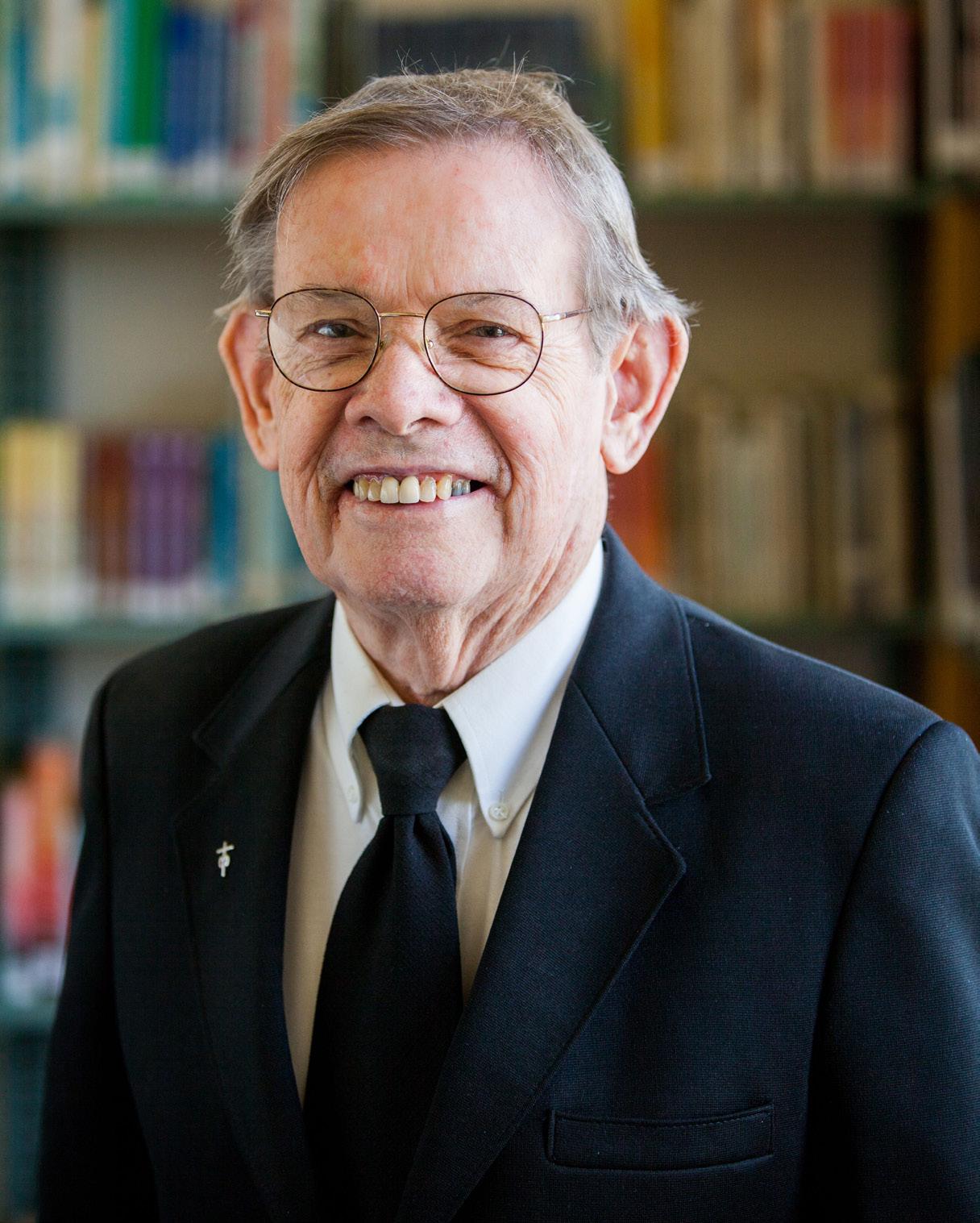

By Lainey Gerke ’28
This year, one of the biggest additions on Riordan’s campus is the new student park.
Previously, this area was an empty space in the middle of the school containing a single table. The location was rarely visited; however, it evidently had the potential to improve.
The inspiration to create the student park came from the former president in 2018, Andrew Currier. Prior to the decision of creating the park, there was a debate between either adding a new building or developing an open space for students instead. Eventually, after a discussion between Vice President of Enrollment Danny Curtin ’08, President Tim Reardon, and
Currier, it was decided to develop the park.
It took one year to build, costing $500,000. Curtin shared that they raised the money from the annual fundraiser around the park and by soliciting donations from major donors. The decision to name the park the Student Park came from Reardon.
According to Curtin, the park is “a space for student engagement” and “a place where they can feel comfortable to do work, be social, and be happy.”
The once empty space has been transformed into a recreational area covered by synthetic grass and includes many different places to sit and relax. Protected by the wind, the park is located in the middle of
on the first 50 years of the school.
Current provincial of the House of Bolts and English teacher Michael Vezzali-Pascual ’88 said, “I think we’re absolutely animated by his spirit and his love of Riordan.”
Bro. Bolts served on the Provincial Administration, ministered at the Newman Center at UC Santa Cruz, and spent more than 10 years as the assistant administrator at Queen of Apostles parish in San Jose.
Additionally, he briefly served in the Religious Education Office for the Archdiocese of Vancouver in British Columbia. Afterwards, he retired to the Marianist Center in Cupertino in 2009.
Vezzali-Pascual added that through Bro. Bolts, “I was also able to learn a lot about the Marianists and why the Marianist charism is so important.”
The impact and legacy that Bro. Bolts left at Riordan are deep and will continue to be present throughout multiple generations of Riordan students and faculty alike.
the school as an easily accessible area for students to gather.
Now, the park contains several tables and benches with additional chairs for larger groups. Bushes with purple flowers brighten up the space. The grass in the middle of the park invites students to lie down and enjoy the sunlight.
Students have commented that the new park is a friendly environment for classes, catching up on homework, and socializing with friends. “The student park has provided me with a relaxing place where I can clear my mind and talk to friends,” said Antonio Gilton ’28.
Teachers enjoy the space as well, with some of them using it for their classes and as a space to do work.
Theology instructor Jon Yeager recalled, “Last year, during my first year here, I often sat outside in this space at the old tables … It wasn’t an inviting space to say the least. Students would always tell me that it was a sad scene to look out the windows and see me sitting by myself … I guess the administrators had some sympathy.”
He continued to share that the park “which is far more beautiful than it was,” will hopefully inspire “Riordan students to use their minds, hearts, and friendships towards good things.”
While there are currently no plans to further enhance or change the park, Curtin stated, “Mr. Reardon and I are full of surprises.”

By Aarav Agrawal ’28
During the summer, students and faculty ventured to the Philippines and followed the thrilling journey of Jay Reguero, reading the book “Patron Saints of Nothing” by local author Randy Ribay.
On Sept. 25, Ribay gave a presentation in the Lindland Theatre, stirring conversations that reverberated throughout the hallowed campus. This is the first time a summer reading author has visited the Riordan campus in 10 years.
During the presentation, Ribay talked about his early life, discussed his general writing process with respect to “Patron Saints of Nothing,” and answered questions from various students and faculty.
Afterwards, students had the opportunity to pick up Ribay’s new book “Everything We Never Had” and also get their copy of “Patron Saints of Nothing” signed.
“When I was growing up, I did not want to be a writer. But I loved stories… I never thought that was a career that I could have.” Ribay said, “To my parents’ horror, I switched my major [from aerospace engineering] to English. For the first time in
my life, I started reading from Filipino authors.”
Ribay expressed how he writes in order to answer a question. For “Patron Saints of Nothing,” he asked himself the question: “What right do I have to talk about politics in the Philippines?”
Offering advice for rising writers, he said to “Read like a writer… Be curious about people, about history … [my Filipino culture] had to be something I had to proactively sought out.”
A break from the traditional bell schedule, Ribay gave two 40 minute presentations, with session one for the houses of Russi and Pilar and session two for Bolts and Cana.
The opening remarks came from West Portal Bookstore representative Lillian Van Cleve. Diana Assereto, Dean of Academics, served as the host.
During her opening remarks, Van Cleve emphasized how an entire school community reading the same long-form book “is really special … This doesn’t happen everywhere.”
When asked about how he felt hearing a Bay Area school choose his book for the summer reading, Ribay said, “I’m always honored … [It is] even more meaningful

that it’s this area.”
At the end of the presentation, Art Club presented a portrait to the author, and the Philippine American Coalition gifted him a personalized balikbayan box as a thanks for reminding them to take pride in their culture.
A balikbayan box is a care package sent by Filipino people living abroad to the Philippines.
Zion Mykael Del Rosario ’28 said the novel “honestly exceeded my expectations.”
Likewise, Head Librarian Daniel Appel commented on the book, saying it was “a great selection.”
After Ribay’s visit, Christopher Ding ’28 felt it was “pretty cool for the author of our summer reading book to visit the school.”

By Sofia Peña ’26
Strolling into the new school year, something felt different. Every step down the hallways, students felt grounded as they were greeted by a brand new look: a transformed floor, sleek, gray wall tiles, and a fresh coat of new paint laying at its borders.
Riordan’s most recent summer renovation of the hallways has sparked various reactions across the community with first glances.
When he first stepped into the new space, counselor David Canales ’02 was impressed. “Even if there literally isn’t more physical space, it feels more spacious,” Canales stated.
Besides the new color palette, the renovation has helped to alleviate many safety concerns surrounding the old flooring.
Andrew Colville ’08, Riordan’s Director of Facilities, stated, “The main reason why we chose to renovate the flooring was due to many cracked tiles around the school that were resulting in trip hazards.”
Many Crusaders have taken an interest in the new forwardlooking corridors and its new look.
“The black and brick red floor tiles we felt did not match well the yellow and gray tile along the walls of the school,” Colville explained, later making the

decision to switch over to a modernized, gray-blue tone that fit the hallways better.
Colville emphasized, “It is important to have ‘eye candy,’ not ‘eye sores’.”
“The hallways look more sleek,” Amelie De Juan ’26 said. “They remind me of Animal Crossing.”
With a full transformation of the hallways, Canales reminisced about his time as a Riordan student walking the same old hallways prior to this change.
Canales joyfully expressed, “Any time I walk these hallways … I still feel like I still do some of the student stuff I used to do.
I still jump up and slap the wall.”
When looking towards Riordan’s future, Canales proudly stated, “We’re all figuring out a way to make this a better place every year … and we’re actually doing something about it.”
Though many enjoy the contemporary look, other students are unsure how to feel about the change.
Katherine Baez ’26 gave her first thoughts when stepping into the new hallways, saying, “It looks very bland and modern.”
With Riordan’s ever-changing environment, it’s clear that these new transformations shape Riordan’s pride and vision for the betterment of the school’s future.


By Isaac Martin ’26
Riordan welcomed a fresh set of staff for the 2025-2026 school year with open arms.
Despite the mathematics department receiving the lion’s share of new teachers, each core subject was blessed to receive a brand new addition to their department.
This year, 14 faculty members joined Riordan’s staff: Lindsay Bazela, Errayanna Hatfield, Dan Harlan, Michael Holper, Sylvia Ko, Siobhan Linehan, Aaron McCray-Goldsmith, Vivian Nguyen, Gabriella Panelli, Duke Reeder, Eva Reyes, Carlos Rocha ’10, Meghan Van Koll, and Michelle Wylie.
Rocha, a new social science teacher and Riordan graduate, said, “I knew that I wanted to teach out of high school. I was drawn to the idea of teaching early on.”
On the other hand, for Ko, the decision to start teaching occurred after her time studying
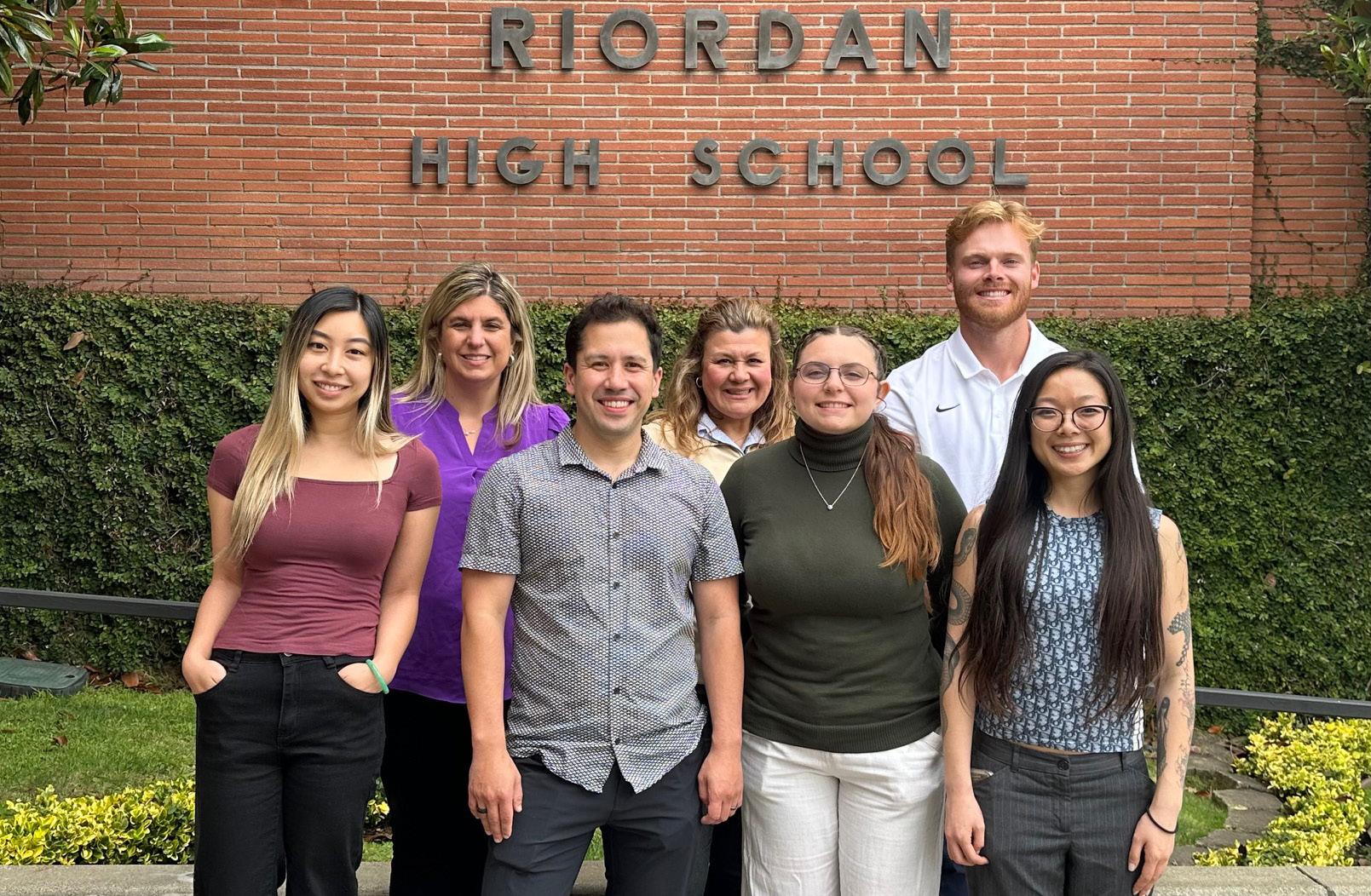
By Aarav Agrawal ’28
teachers have already had a positive impact on the student body.
“I think the class is pretty good. The workload is manageable, and Ms. Nguyen teaches very well and is really kind,” said Brian Tin ’27 about Nguyen’s Pre-Calculus class.
Riordan’s vibrant community and lively SF Bay Area location were two key factors that attracted each new staff member to the campus when asked, “why Riordan?”
astrochemistry at UC Berkeley.
Ko stated, “Even though researching astrochemistry seems exciting—you could figure out the molecules that explain how the world began—who is gonna help Timmy who’s failing math?”
Whether teaching was an innate passion or a calling discovered later on in their career, one fact remains clear: each new teacher deeply cares for the success of their students.
Students agree that the new
“Riordan has a great resource program (RSP). Anybody who has been watching high schools in San Francisco knows that we have a great resource program. I think the culture at Riordan is also among the strongest and happiest, and inclusive cultures,” said Bazela, the newest member of the RSP department.
Whatever the reason for their arrival, Riordan is once again graced by the addition of new, passionate teachers and faculty.
continued from page 1
A GoFundMe was organized by former track athlete Finn McCole, and it very quickly surpassed its initial goal, raising nearly $60,000 to cover medical expenses and help replace items that were stolen during the attack.
In addition, the Riordan community also rallied behind Pellegrino. Students found their own ways to show support.
Four Riordan seniors, Isaiah Sanchez ’26, Avery Agbunag ’26, Aidan Alday ’26, and Diego Meirda ’26 bought Pellegrino a new pair of shoes.
“I have known Mr. P for my whole time here at Riordan,” Alday said.
“He was my religion teacher, track and cross country coach, and my friends and I wanted to give back in any way we could.
We’re just glad he is here with us today,” Alday added.
“As soon as I returned, everyone has been so supportive,” Pellegrino shared. “So many Riordan families have invited me over, and the students and faculty have been really great to me.”
Widely known throughout the Riordan campus for his undeniable positivity, enthusiasm and uplifting spirit, Pellegrino
continues to inspire those around him.
Looking back on the incident, Pellegrino reflected, “The main takeaway for me is that sometimes we forget how precious and fragile life is.”
“We need to prioritize that and remember that people envy what we have and what American values represent. That’s part of why I was attacked.”
continued from page 1
Sutton said, “It was an honor to host NorCal Media Day. We had students from Rocklin to Santa Barbara, and they all came to Riordan to celebrate journalism. The campus was the ideal stage for the event, the weather was perfect, and as always, the students shined.”
Of the many guest speakers, Shasky taught a session focusing on being your authentic self in the world of journalism.
National and World Editor of The Crusader Rachel Gerke ’27 said, “My favorite part of this year was Joe Shasky’s session … I learned that being authentic is an essential part in distinguishing yourself within journalism, as there are so many people just following what they see others doing instead of creating their own unique style.”
Shasky dove into the importance of being yourself, especially in this industry. He explained that it is difficult to reach goals without continuing to persevere and see
things through. He did, however, expand on the consequences that may come with always being your authentic self.
“I think it goes both ways. I mean at times you want to be real, you want to be authentic, but you also have to be careful with how you say it because people take things very, very personally even if that’s not your intention to be personal,” he explained.
Other guest speakers included Jabriel Andrade ’18 and JC Canicosa ’16 from KPIX, and Steven Risotto ’20 from 95.7 The Game.
Andrade taught a session about broadcasting and behind the scenes of being an Assignment Editor for a news station.
Managing Editor of The Crusader Ishaan Gupta ’26 said, “The session that Jabriel gave was very informative and insightful. I really got to learn a lot about the behind the scenes of a news organization that you wouldn’t be able to learn otherwise.”
Andrade explained the level of of importance an assignment
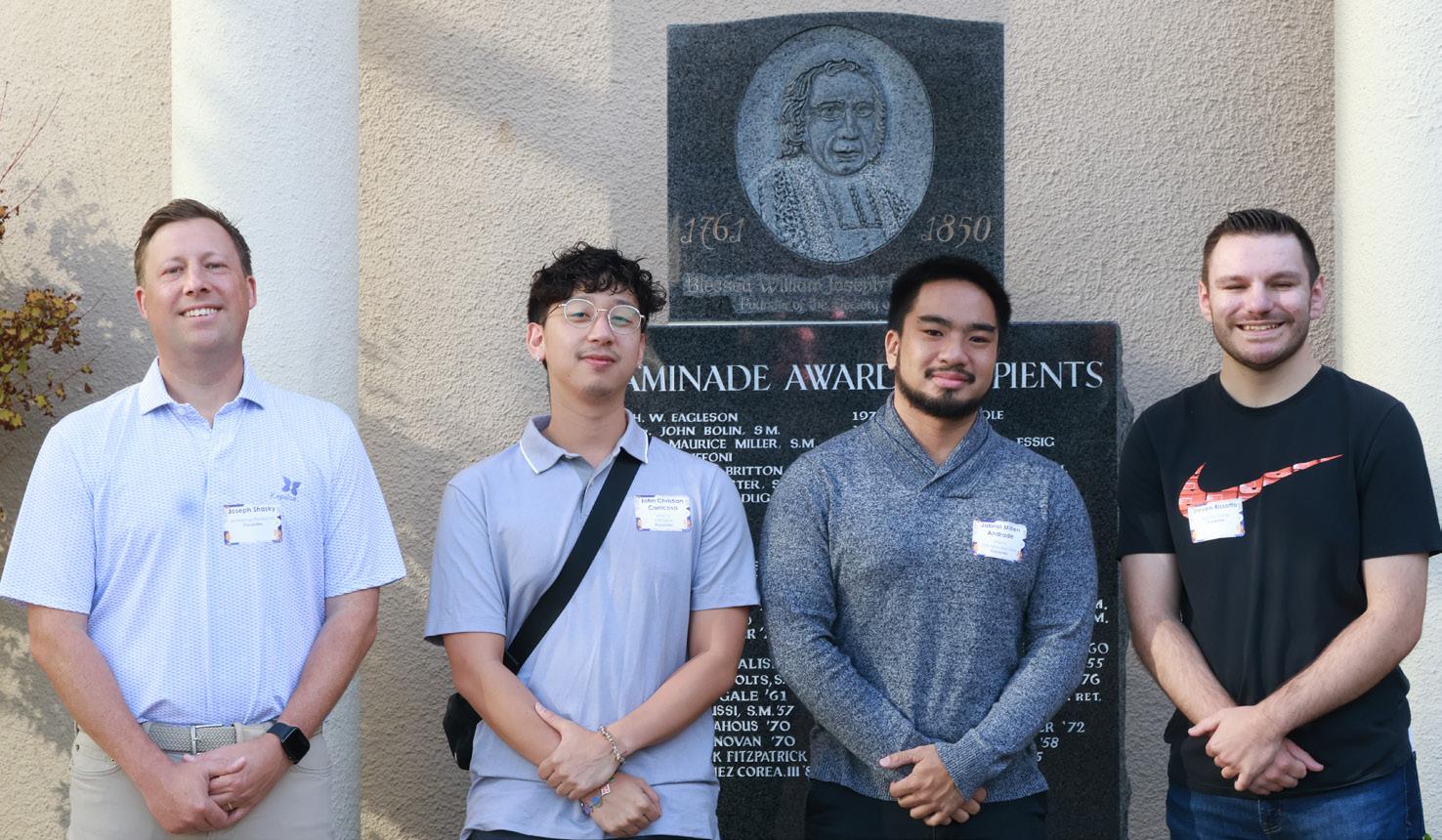
editor holds. They work in a constantly moving environment and are responsible for countless tasks such as assigning reporters and photographers, managing breaking news, and handling every day logistics.
As Riordan hosted NorCal Media Day for the first time, it turned out to be a success.
Students from different schools
were able to come together as a community based on a mutual love for journalism, where they learned skills and gained inspiration.
“Be willing to outwork everyone else in the room, for a long time,” Shasky advised. “Hard work truly pays off…You have to see it through, you can’t expect immediate results.”
By Julian Amann ’26
In the past two months, Ocean Avenue and neighborhoods nearby have experienced several fatal incidents, from stabbings to pedestrian deaths.
These unexpected tragedies has had residents question their safety and responsibility.
Sept.10, 2025
On the afternoon on Sept.10, a 35-year-old man named Robert Paul Byrd was walking on Junipero Serra Boulevard and Ocean Avenue with his 8-yearold son, when he started to argue with a man on the sidewalk. According to news reports, Byrd walked into the crosswalk when he was confronted by a man, who allegedly stabbed him.
He suffered severe wounds and was taken to the hospital immediately, where he eventually spent his last moments of life. The San Francisco Police Department acted quickly, getting together a search team for the arrest of the man. Within days, he was found and arrested on the scene, four hours away in Tuolumne County.
In a news conference, Interim Police Chief Paul Yep said the scene was “horrific,” explaining how terrible it was to have children present during an attack like this. Across the street is Commodore Sloat Elementary, and their community felt threatened and shocked.
The district sent out letters to all families for support, like counseling for students.
In recent days, neighbors put flowers and candles on the spot of the sidewalk where Byrd was
killed in support of his son, who witnessed the event. The suspect was charged with murder and child endangerment and is awaiting trial.
Aug. 2, 2025
On Aug. 2, an 83-year-old man was hit by an oncoming vehicle in the intersection of Ocean and Lee avenues. He was rushed to the hospital with severe injuries and died days later. The driver remained on the scene, and the investigation is continuing.
The crash was noted by traffic safety advocates, such as Walk San Francisco: “It was the city’s eleventh pedestrian death of 2025, and a high number of the victims were older people.”
The intersection is listed in the High Injury Network in San Francisco, pointed towards streets where crashes happen frequently. The city responded by working on the K Ingleside Rapid Project, which reconstructs street layouts, paving crosswalks, and adds speed cameras from Junipero Serra to Balboa BART Station to monitor anyone going over the speed limit.
One of the cameras was installed on Ocean Avenue and Frida Kahlo Way, close to the site of the incident. Supervisor Myrna Melgar pushed the Street Safety Act to start San Francisco’s goals and create a safer environment. Members of the community showed empathy for the victim and his family by placing a sign near the fatal crash.
July 26, 2025
On July 26, there was an attack at the Muni station on Ocean Avenue and Lee Street. A 28-year-
old man named Colden Kimber was stabbed to death, and the SFPD said it was an “unprovoked” act of violence. His death drew attention to the fact that this happened in a public space, with cameras and witnesses.
According to the district attorney in published reports, Kinder was with his girlfriend, and they were on the platform when they saw a man harassing women.
Kimber confronted the man identified as Sean Collins about his actions, and Collins allegedly fatally stabbed him in the neck with a 6-inch blade. Kimber tried to protect himself, but fell onto the seats in a matter of seconds. Two children witnessed the violent attack, as well as many who were out on that Saturday afternoon.
Collins was arrested shortly, in front of the library a few blocks away. He was later charged with murder, use of a deadly weapon, and child endangerment.
Kimber has been remembered by many, especially the cycling community. Friends and family have created a memorial in honor of Kimber, and a GoFundMe link to raise awareness and support for his family.
“It’s scary going to Ocean every day knowing that these incidents have happened,” said Amisha Shankar ’26. “Even if I’m just trying to get groceries I feel unsafe and feel the need to carry pepper spray, especially as a girl.”
While each tragedy is different, they create an awareness of the weakness in everyday places like sidewalks, intersections, and city transportation.

In response to these attacks and tragedies, the city has been moving step by step, forced to do more. There have been upgrades to the city so that citizens feel safe and not scared to walk in public, and recent crime statistics note that homicides in San Francisco are on par to be the lowest since the 1950s.
“Walk in groups, keep your head out of your phones and always look around your surroundings and get a sense of who’s around,” said Viggen Rassam ’87, Riordan’s Director of Safety and Logistics. “If you don’t feel comfortable, go into a store and ask for help.”
By Adriana Alvarado ’26
“The Whales” are back, and have found a new home on the City College of San Francisco campus.
The statue has returned to public view after being stored away for almost 20 years. It’s now outside of the brand-new Student Success Center, on the eastern side, parallel to Ocean Avenue. The building is now open, so students can see the sculpture in the courtyard as they walk to class. Many see the statue as a symbol of creativity and resilience for CCSF.
The statue has a long history. Artist Robert B. Howard created “The Whales” in 1939 for the Golden Gate International Exposition on Treasure Island.
After the fair ended, the orcas spent years in Golden Gate Park and later in front of Steinhart Aquarium at the California Academy of Sciences. For decades, they were a sight for tourists, especially for school kids on field
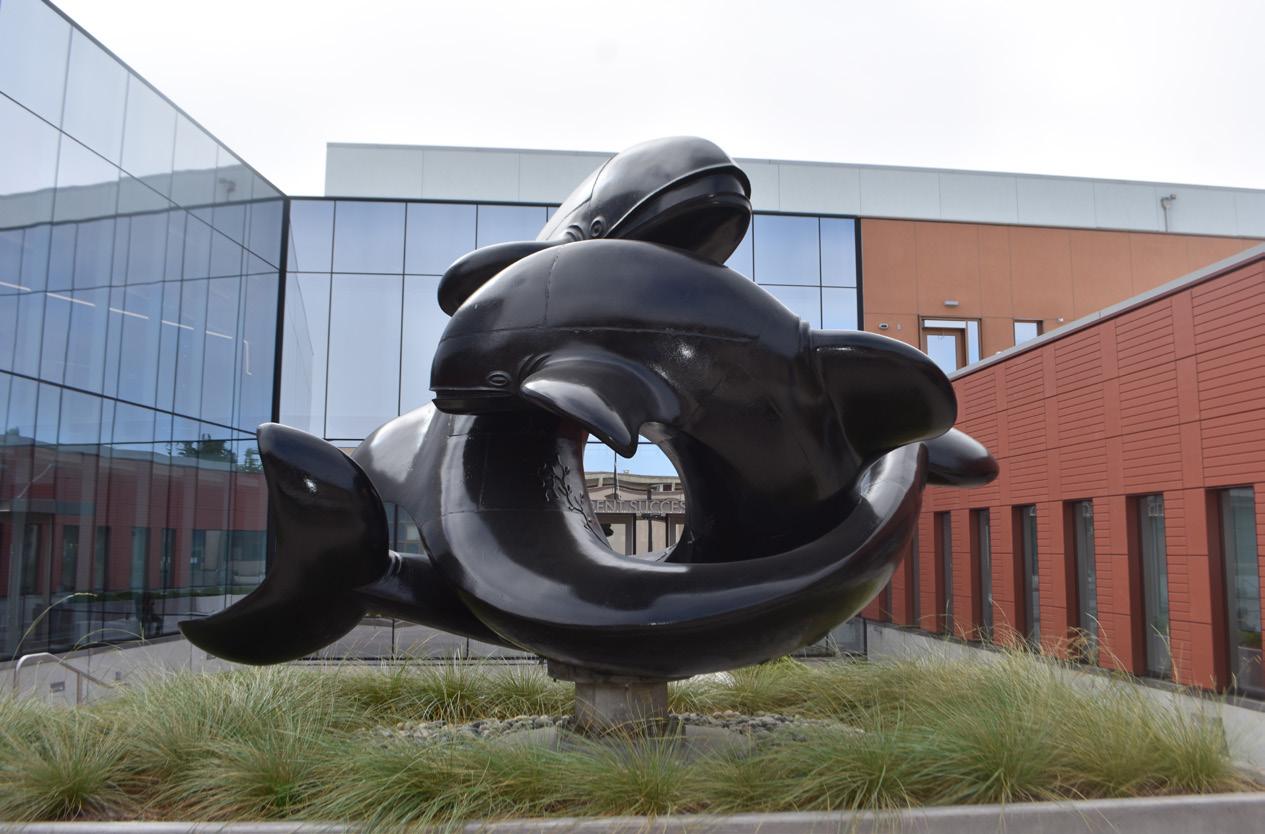
trips, with many posing in front of the famous sculpture, which also had a fountain.
When the Academy of Sciences started its major renovation in the early 2000s, the whales were taken down and moved to CCSF where the statue was stored. They were left outside, covered by tarps, and exposed to San Francisco’s variety of weather. Because of this, they became rusty and badly
damaged over time.
In 2019, the San Francisco Art Commission decided to restore them. The statues were carefully moved into a workshop located in Oakland, where the crew repaired the structure, cleaned off years of grime, and gave it a new refurbished look that would last. After all that work, they’ve finally come back to CCSF to take their place right outside the Student
Success Center.
For many people, “The Whales” are more than just a public piece of art. They are a reminder of the city’s past. Some students shared their thoughts on these cherished statues.
“The Whales look like they are swimming towards each other,” said Jaeda Villasenor ’26. “They look like they have a deeper meaning. They show the dynamic between the two whales.”
Luke Murillo ’26 said, “It’s a really nice statue. I think it’s a nice addition to the campus. It makes it more lively.”
Even though the orcas won’t be sitting in the fountain like they used to, they now sit in the central courtyard where everyone can see and enjoy them.
After years of being forgotten, the statue is back and looks better than ever. It brings a piece of San Francisco history to the campus and shows how CCSF values keeping art alive for future students and visitors.
By Jordyn Flores ’27
The well-known mural, Pan American Unity, created by famous Latino artist Diego Rivera was crafted in 1940 on Treasure Island as a part of the Golden Gate International Exposition.
Rivera made the vibrant mural as a gift to San Francisco.
In the mural, Rivera highlighted American culture, politics, and religion while also portraying the Latino community and its role in American history. The painting was made to show the individuality and likeness of both Latino and American society.
Since it was created, it spent many years at the Diego Rivera Theatre at City College, and then time in storage being restored, followed by a stint at the SF MOMA, but in recent developments is intended to move back to the CCSF campus theater on Frida Kahlo Way when it is completed.
Many feel this is where the mural should stay, seeing as Rivera was Frida Kahlo’s husband.
Juvenal Orozco ’26 shared, “As a Latino, I feel proud that his art
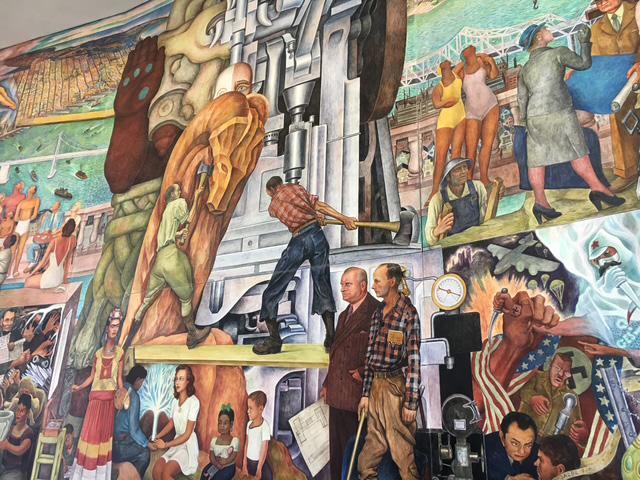
“Since human histories are cyclical, many themes in artworks like these come and go, become old but then also become fresh and new. It is important to make these connections across time.
Irman Arcibal, Art teacher
is finally coming out of storage,” he said.
“This street has no meaning right now, and I think this painting will fix that.”
Many feel a special connection to the mural.
Kathleen Demeter ’27 voiced, “Especially with everything going on with ICE and deportation, the mural shows that Latinos make up a significant part of our culture,” she said. “They are just as much Americans as we are and this painting says that.”
Art teacher Irman Arcibal expressed, “Since human histories are cyclical, many themes in artworks like these come and go, become old but then also become fresh and new. It is important to make these connections across time.”
With San Francisco being a sanctuary city, students feel Rivera was ahead of his time in giving Pan American Unity to the community. Moreover, even after over 80 years, the painting still holds value and relevance to current world events.
By Miki Maloney ’26
As tensions regarding gerrymandering in California and the larger United States mount, the future of California’s district organization will lie in the hands of its voter base.
A special California ballot is scheduled for Nov. 4 to determine the fate of California Governor Gavin Newsom’s Proposition 50. This proposition, if written into law, will reorganize the map of the state’s congressional districts between the years 2026 and 2030.
“Proposition 50… would allow Californians an opportunity to bring some much-needed accountability to the Trump administration,” stated Governor Newsom on his official webpage.
This action by Newsom comes most directly in response to similar redistricting in the state of Texas, which won five new seats in the House of Representatives for the Republican Party. This passage garnered heavy backlash, particularly due to its reliance on a representative vote in the Texas state House rather than the decision of the citizenry.
Opponents of Texas’s decision pose that this action, taken without the vote of the people, will heighten the disconnect between policy and the people it affects. California’s redistricting proposal, in comparison, distinguishes itself in its reliance on a popular vote. Proponents argue that this choice, while retaliatory, more potently reflects the will of the people.
“This is a reaction to another

state that wants to gain more power in the House,” said AP US History teacher Cory Nelson.
The five seats won for the Republican Party in the redistricting of Texas could provide a major swing for the party in decisions later down the line. California’s actions could be seen as an act of counterbalance to such a major shift in the party lines.
However, the deeper implications of California’s potential involvement in the redistricting effort have turned some skeptical eyes to the proposition.
“Aggressive redistricting as a retaliation shows how easily political power can be consolidated at the expense of fair representation,” said AP Government student George Gamarra ’26.
Many of those opposed to the proposition fear that the normalization of changing district lines to suit partisan interest weakens the power of the citizen voter.
“Ultimately, if every state engages in strategic redistricting,” Gamarra added solemnly, “political parties, not voters, will
determine election outcomes, weakening our nation and undermining the principle of fair and equal representation.”
The vote is still yet to be decided, and many in California are still struggling with the nuances of this decision. The prevailing sentiment, though, has been an emphasis on ensuring the endurance of the people’s place in their democratic system.
“Democracy is about choice, about a perceived fairness,” said Nelson. “And when that fairness is taken away, we lose out on democratic processes.”
By Rachel Gerke ’27
On Sept. 10, conservative activist Charlie Kirk was fatally shot during an event at Utah Valley University, leaving his wife and two children to grieve. He was pronounced dead around 3:40 p.m., shortly after he was taken to the hospital. His assassination appears to have been an act of political violence.
The murder suspect, 22-yearold Tyler Robinson, was charged with seven counts, including one of aggravated murder in his first court appearance on Sept. 16. Text messages between him and his roommate following up to the murder were revealed by investigators, which suggests that he may have been planning it for over a week. They also reveal his primary motivation, which stemmed from ideological hatred.
Many political leaders spoke out about the murder, including Vice President JD Vance and former President Barack Obama. They expressed outrage at the assassination, and called for national unity.
In a post on X shortly after the murder of Kirk, Obama wrote, “We don’t know yet what motivated the person who shot and killed Charlie Kirk, but this kind of despicable violence has no place in our democracy. Michelle and I will be praying for Charlie’s family tonight, especially his
wife Erika and their two young children.”
While hosting a tributary episode of Kirk’s podcast “The Charlie Kirk Show” a few days after his death, Vance stated, “The last several days have been extremely hard for our country, they’ve been hard for me, hard for my family, hard for the countless people in this building who knew and loved Charlie Kirk, and of course they’ve been hardest most of all for his darling wife Erika and their two beautiful children.”
As a result of violent acts such as the murder of Kirk, larger views have been articulated reflecting on the divided state of the country, and the consequences that have resulted. Many feel that political polarization in America has led to the inability to have civil discourse with those that have opposing views.
Theology teacher Jon Yeager said, “Our vision of humanity is skewed and we’re seeing people more as political positions rather than a human being that’s made in the image of God.”
According to a Reuters/Ipsos poll published on Sept. 16, 63 percent of adults currently believe the country’s political discourse significantly promotes violence. For some, the rise in such political violence can be interpreted as a reflection of ideological division.
“It’s hard to realize that most

people don’t live in an extreme camp of far left or far right,” said Robert Bennett ’27. “Most people are just like you and me, trying to make sense of the problems that we have in this country, based on their personal world views while also being bombarded with messages that are telling them to pick a side.”
By Matthew Nicolas ’29
The death toll of war journalists and media workers in Gaza has risen to 239, according to the Committee to Protect Journalists. After months of intense fighting, many journalists find themselves living in tents with limited access to food and water.
Bob Harrington, a social sciences teacher, highlighted that these deaths signify a “crisis in freedom of the press.”
The Israeli-Palestinian conflict erupted on Oct. 7, 2023, when the Islamic militant group Hamas launched an attack that killed over 1,200 Israeli citizens and took 251 hostage. Israel retaliated by cutting off food, water, and power to Gaza, leading to a war that has claimed tens of thousands of lives and devastated the region over two years.
Amid this, war journalists have become both witnesses and victims. Notably, Al Jazeera correspondent Hossam Shabat was among the media workers killed in the conflict, dying on March 24.
Modern conflicts like this have become some of the deadliest in recent history, with war

Image provided by Wikimedia Commons
According to the Committee to Protect Journalists, an estimated 239 journalists have been killed in the Israel-Gaza War since it began.
journalists risking their lives to inform the public. Shabat and others help shape the understanding of world conflicts, often facing extreme danger in a journalism landscape filled with censorship and violence.
Martin Novoa ’26, who researched Ernie Pyle for a journalism project, shared insights on how Pyle’s work influenced public perception in the past.
Pyle was a pioneering war journalist who brought the brutal
realities of World War II into American homes through personal accounts. As Pyle reflected on the German bombing of London in 1940, he wrote, “For on that night this old, old city… was the most beautiful sight I have ever seen. It was a night when London was ringed and stabbed with fire.”
Novoa expressed, “Journalism today, especially in terms of war reporting, is most definitely more dangerous than before… higher-ups with bad intentions possess better ways to cover up information, making it easier to take out opponents.”
A ceasefire agreement between Hamas and Israel was signed on Oct. 7, with the United States brokering the deal as regional leaders supported it. Hamas began releasing Israeli hostages while Israel freed nearly 2,000 Palestinian prisoners.
Although humanitarian aid is pouring into Gaza, violations and air strikes raise doubts about the ceasefire’s sustainability, leaving lives at risk, including journalists. This leads many to question if being a war journalist is becoming as perilous as being a soldier on the battlefield.
By Logan Dee ’26
After the postponement of Carlo Acutis’ canonization in April, Pope Leo XIV officially declared Carlo Acutis a saint on Sept. 7, making him the first millennial saint.
According to AP News, on the morning of Sept. 7, an open air Mass took place in St. Peter’s Square in front of an estimated 80,000 people. Many were millennials and couples with young children.
In his homily, Pope Leo XIV stated, “The greatest risk in life is to waste it outside of God’s plan.”
Before this day, however, the Vatican stated that there were 36 cardinals, 270 bishops, and hundreds of priests who wanted to celebrate this special Mass alongside Pope Leo XIV.
This support and showing of thousands of people is a result of what Acutis did in his lifetime.
Acutis was born on May 3, 1991 and died on Oct. 12, 2006. During his lifetime, he studied computer science and indulged himself in the knowledge of college-level books on programming even as a young man.
He documented Eucharist miracles on web pages that are still used for religious instruction in parishes around the world, which is what he is widely known for today.
Daniel Reyes ’26, a dedicated Catholic, said, “God gave Acutis wisdom and knowledge not only for his own growth and learning, but also so he could share God’s message with others.”
However, in October of 2006, he was diagnosed with acute leukemia, and within days, he died.
Upon his request, he was entombed in Assisi as he wanted to be buried at the site of St. Francis of Assisi.
An early sign of respect for Acutis could be seen at his burial site. Millions of young Catholics have visited him where he is dressed in ordinary, everyday clothes such as jeans, Nike sneakers, and a sweatshirt.
Donatella Cirelli ’28, a leading member of Campus Ministry, said, “He’s someone the younger generation can relate to because he was of the younger generation.”
He has been considered for sainthood since 2013 and was going to be declared in April. However, because of Pope Francis’ death, Acutis’ canonization was postponed.
In spite of the postponement, Pope Leo pushed for Acutis’ sainthood journey, believing that the church needed someone like him to attract young Catholics to the faith while still addressing the digital age.
Carlo Acutis’s work and canonization will be a sainthood journey that will continue to resonate with young people around the world

By Luna Weng
’28
September 3 marked the 25th anniversary of the beatification of Blessed William Joseph Chaminade. Chaminade was a French Diocesan Priest during the late 1700s whose piety was as strong as ever.
According to the Marianist website, around the time of the French Revolution from 1789 to 1799, citizens of France had to pledge allegiance to an anti-religious government. Courageously, Chaminade chose to go against the government and to pledge to the Roman Catholic Church and Pope Pius VI instead. He secretly continued his work as a priest despite a possible death penalty.
Reegan Jones ’28, a devout Christian churchgoer shared, “I think that his rebellion was brave considering that the government was against him at that moment. He wanted to pledge his loyalty to the pope who is like a successor of Jesus and looking after us and the religious community.”
In 1797, Chaminade was exiled to Saragossa, Spain due to his refusal to pledge an oath to the French government and to avoid persecution. While in Saragossa,
Chaminade prayed to the Lady of Pillar every day.
After the French Revolution ended, Chaminade returned to France. This time, he was determined to spread Christianity in all of Europe.
Chaminade collaborated with others with a similar goal to construct sodalities, groups of brothers and sisters. Sodalities were a way to regrow the mission of Mary in Europe after the French Revolution’s anti-religious government.
Chaminade assisted in the formation of a sodality named the Society of Mary, also known as the Marianists. He guided male sodalists in promoting the Apostolic mission of Mary. Eventually, over 1,000 members from all different ages, genders, and social classes were spreading the mission. Today, there are over 10,000 members in the Marianist Family.
Deacon Chris Mariano stated, “If we look at the global impact of Chaminade’s message, it has really helped in many communities around the world –over 30 countries and has gone across the countries of Africa, Asia, Europe and the Americas.”
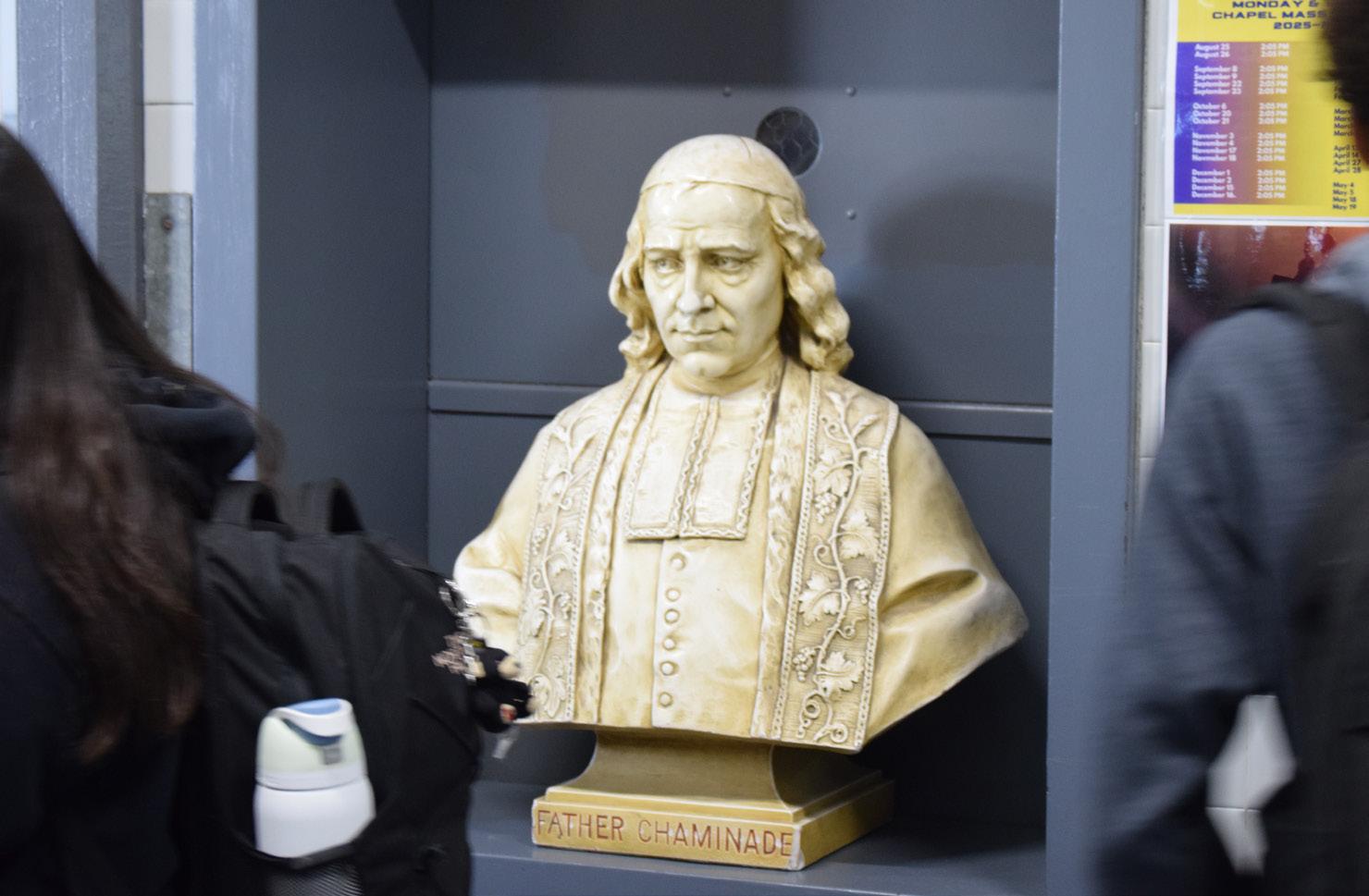
“If we look at the global impact of Chaminade’s message, it has really helped in many communities around the world.
- Deacon Christopher Mariano
On Epiphany Day, Chaminade suffered a stroke which led to his death two weeks later on Jan. 22, 1850, in Bordeaux, France. He was surrounded by the members of his sodalities and was soon buried in the city of Bordeaux. In 2000, 150 years after his death, Chaminade was beatified on Sept. 3 by Pope John Paul II, acknowledging that Chaminade has truly enhanced Catholicism around the globe.
By Robert Bennett ’27
When you come into school, your iPad connects to the internet before you even sit down. Your assignments print on the first try. Schoology loads instantly. But if any of that fails tomorrow, chaos would follow, and there are two people who make sure it doesn’t.
IT Director John Wu, who’s been at Riordan since 2011, and IT Manager Trejon Bolden ’12, a Riordan alumnus who returned in 2017, handle everything from network crashes to printer jams to teachers who can’t figure out why their classroom TV won’t connect. Together, they support around 1,300 students, faculty, and staff.
“Being a Riordan alumnus, it feels good to give back,” said Bolden, who worked his way up from IT Support Specialist to manager.
Their job means being on call around the clock. “Because we have a dorm on campus, we’re essentially monitoring the network 24/7,” Wu explained.
When water leaked into a network closet, Wu got the call at midnight and worked until 4 a.m. replacing equipment.
Each morning, they check what broke overnight, then divide the
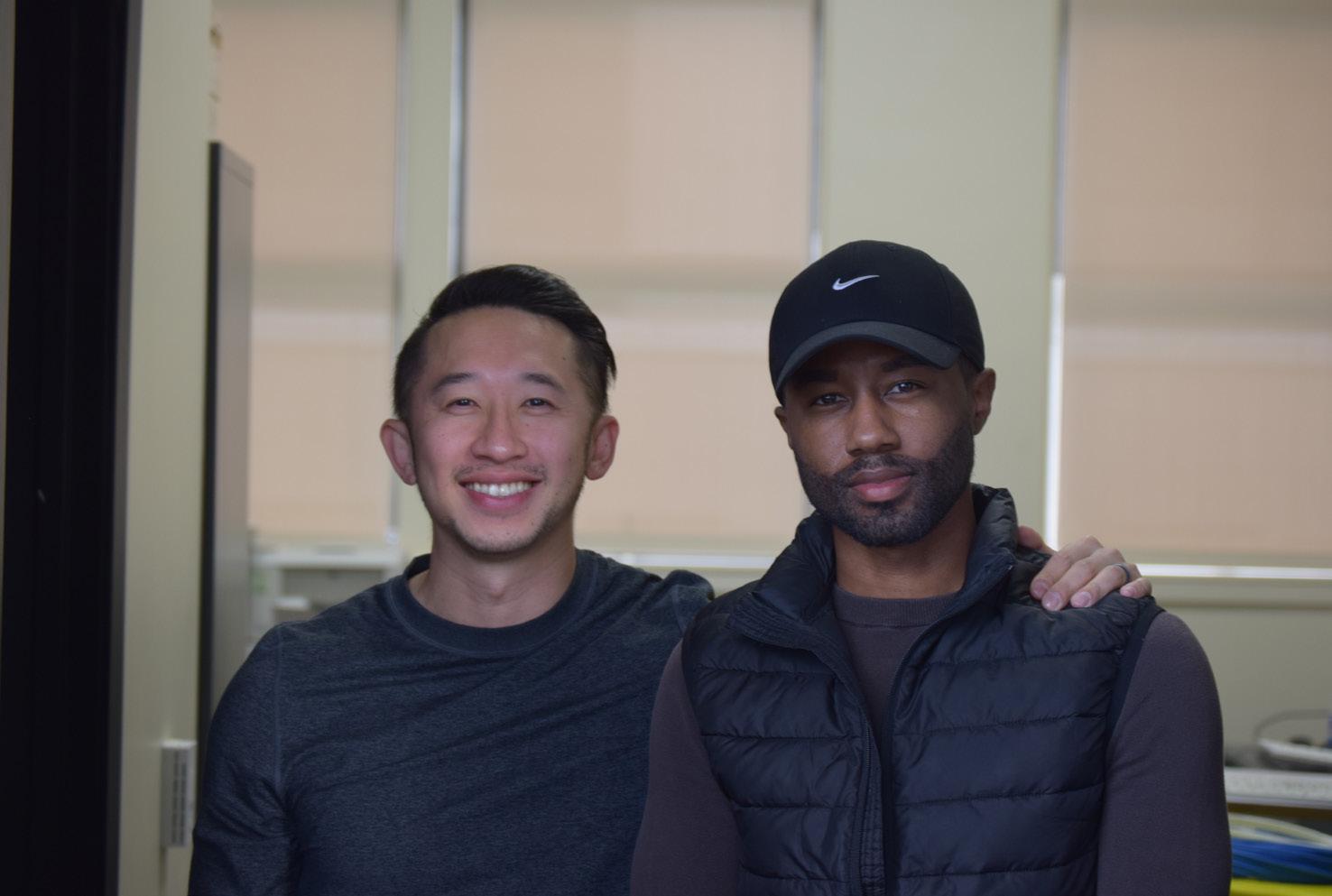
day’s work.
They even fix the school’s copy machines. “Even something as simple as using the wrong paper color or not selecting the correct paper setting can trigger jams,” Wu said.
Students take this technology for granted, but it represents a massive transformation since Wu arrived. In 2011, Riordan had no Wi-Fi and just two computer labs. Today, every student has an iPad, and classrooms have smart displays.
“By 2014, we rolled out Wi-Fi
and a one-to-one iPad program. In 2020, we revamped the network to support the shift to co-ed.”
For students, this work happens mostly behind the scenes. Matteo Hrvatin ’27 remembers when he couldn’t access documents on Schoology.
“Technology has made my experience better because it allows me to access several things at once,” Hrvatin said.
What do students not see? Wu and Bolden work evenings and weekends to keep those systems running.
The hardest part isn’t handling emergencies—it’s finding time for the big projects that keep Riordan ahead of the curve. Wu and Bolden get just two to three weeks during holiday breaks to implement major upgrades. The rest of the year, they’re in maintenance mode, putting out fires and planning for the next break.
“No two days are the same,” Wu said. One minute he’s troubleshooting the network, the next he’s helping a teacher connect their laptop.
“When everything’s running smoothly, our work is invisible— which is exactly how it should be,” Wu said.
He added, “But that takes constant monitoring, updates, security patches, and planning behind the scenes.”
Looking ahead, Wu gets excited about AI and adaptive-learning platforms that could personalize instruction for each student. But most days, he focuses on the basics: keeping the internet fast, the printers working, and the network secure.
Wu and Bolden work nights, weekends, and holidays so students never have to think about whether technology will work. It just does.
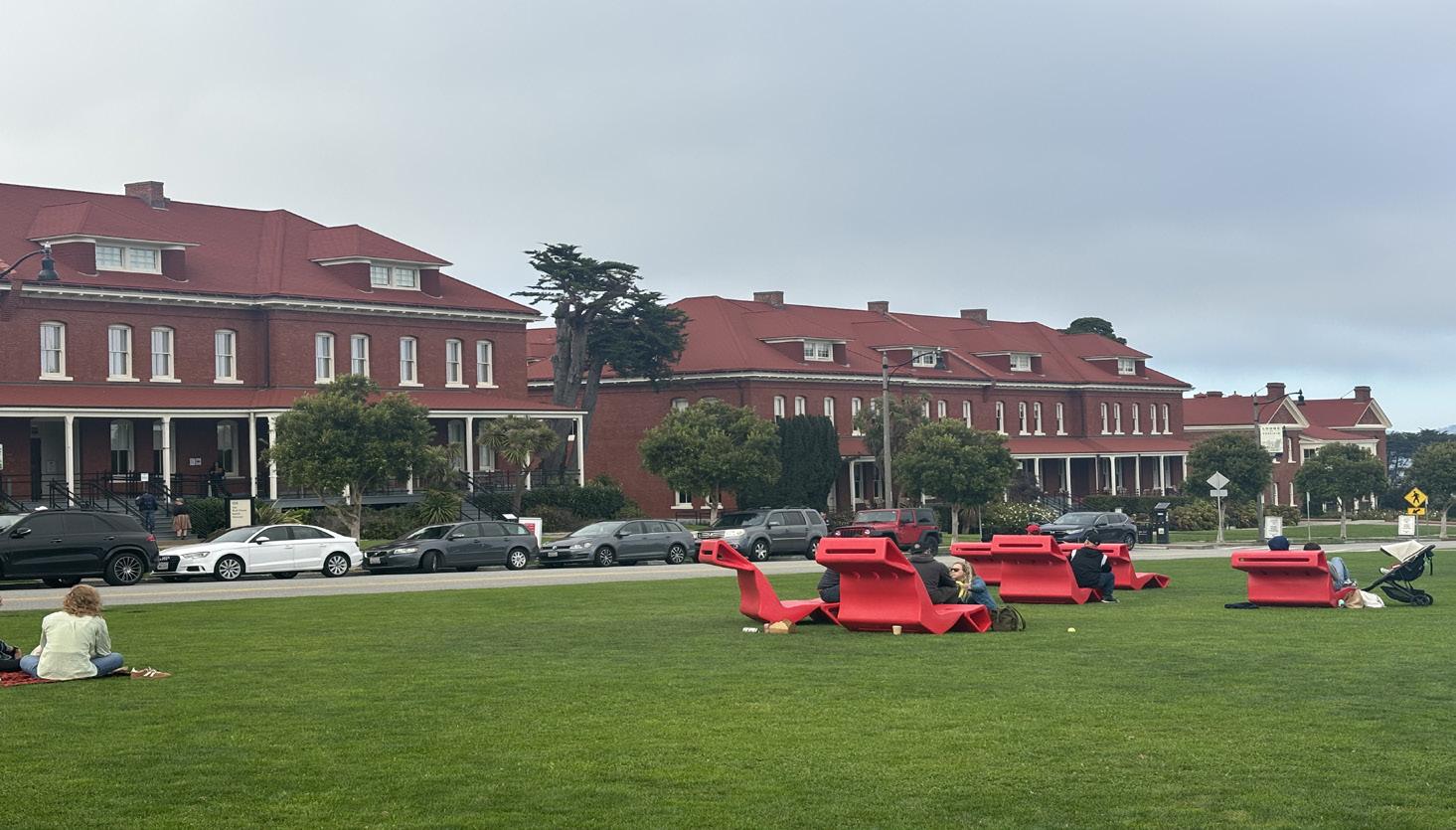
Photo by Lorelai Keating-Curran ’27
By Daniela Krasnoshchok ’25
San Francisco’s Presidio Park has it all: beautiful views, curious animals, endless tourists and, of course, a little mystery to it. Just 100 years ago, the Presidio looked very different. Nowadays, offices and museums are standing in place of the U.S. Army post, but the spirit is still there.
“The Presidio is a beautiful spot to go to. I find it peaceful, especially since I moved here from San Luis Obispo. There’s a great cafe and amazing views, but I have heard some strange things about ghosts in this park. Never encountered one so far,” said CCSF student Alayna Hernandez.
Not many locals and tourists know about Presidio’s past.
Originally, it was home to indigenous people before being taken over by Spanish, Mexican, and American forces.
In 1906, it was a refugee camp for the survivors of the earthquakes and fires it left behind. In 1917, during World War I, it was an Army base for new and wounded soldiers from the front. Soon after, during World War II, the Presidio was considered military headquarters, and was responsible for the West Coast defense.
“We learned Presidio’s story in my history class and my teacher said he encountered an unexplainable object movement while he was at his office, right by the Disney museum. My buddies
and I went ghost hunting the other night and we heard someone following us, but no one was there. We all got goosebumps and went home,” said Yevs Krasnoshchok, a student at The Bay School of San Francisco.
There were a lot of coincidences that even some skeptical people started believing in ghosts. There are just things you can not explain.
Some people say it’s a captain who follows kids and teenagers so they won’t get in trouble and keeps them safe. Others say it’s an evil spirit, and you shouldn’t be in the Presidio at night.
I have myself encountered an unexplainable situation. I went to Presidio Tunnel Tops, also known as the “red chairs.” It was pretty late at night as I was walking to the chairs to sit down, but I could see someone following me in the corner of my eye.
Every time I turned around, there was no one. For some incomprehensible reason, I still decided to stay before something freaked me out. It was a voice.
Not a sweet or melodic voice. It sounded like it saw my soul from the inside out, waiting for me to be scared. It whispered my name. That was the last straw for me. I got up and left in tears. In fact, I was scared.
After sharing a story with one of the locals, Adaline Richy, she told
“Presidio is a beautiful spot to go to. I find it peaceful, especially since I moved here from San Luis Obispo. There’s a great cafe and amazing views, but I have heard some strange things about ghosts in this park.
- Alayna Hernandez, CCSF student
me she witnessed a very similar incident once. “I heard someone say my name when I went for a walk to clear my mind about three months ago. It creeped me out and I called my husband, just in case,” said Richy.
The Presidio appears on several websites about haunted locations in San Francisco, including SFGhosts.com, which notes, “Many believe the Presidio’s grim history of conflict, disease, and death spanning centuries has left its imprint in the form of spectral manifestations. Tales of ghostly apparitions, cold drafts, and disembodied voices are common in several of the Presidio’s historic buildings, courtyards, and cemeteries.”
While Presidio Park is one of the main tourist attractions in San Francisco, it keeps its own secrets, hiding in the dark, waiting for you to uncover them. So the next time you go there, don’t forget to look behind you.
By Hazel Nagata-Rampata ’26
The reptile, the myth, the legend, the local albino celebrity, Claude the alligator has turned 30 years old!
The California Academy of Sciences star celebrated 30 years of Claude with a 30 day celebration–called the “Hatchbash”–throughout the month of September.
In 1995, Claude hatched on an alligator farm in New Orleans, Louisiana. After his hatching, he was transferred to a specialty zoo in Florida. He resided there for 13 years until 2008, being brought across the country to the California Academy of Sciences.
In the early days of Claude’s residence at the Academy, he lived with a female greencolored alligator, Bonnie. But, in early 2009, Bonnie was found to have bitten Claude’s pinky toe, causing the pair to be separated. Claude returned to the Academy afterwards, now with the spotlight solely on his pearly white skin and big toothy smile.
Claude has become quite a celebrity throughout the years, with the albino alligator catching the eyes of hundreds every day.
Though Claude himself couldn’t provide any quotes, Emma, working in Guest Experience at the Academy, said that the Hatchbash has been, “Pretty fun!

It’s been fun seeing people dress up and it’s enjoyable to see people celebrate his birthday from all over California.”
The Academy was decorated with striking posters of Claude, statues, and even a mascot of Claude walking around. Activities included writing a happy birthday card and buying hoodies with his likeness, and taking photos
with Claude. Many agree that the Claude cut-out hats really chomped down on making this party a true birthday bash.
Visiting Claude’s exhibit, Brock Garcia ’26 said, “I think it was great. I really thought the huge birthday card that everyone could write on was great, and shows just how much everyone appreciates how long he’s been around.”
He added, “I had a great time seeing all of that and showing some love to this dude Claude.”
One interesting fact about Claude, is that “Since he is mostly blind and doesn’t move around a lot, his hands are very soft,” said Emma “He’s our little pampered princess with his heated rock, hand-fed food, and his pet turtle. He’s a very chill guy.”

By Elise Robinson ’28
San Francisco is home to two sundials, one in Ingleside Terrace and the other in the Bayview District.
A sundial is one of the oldest tools for telling time, using positions of the sun’s shadow to mark the hour. As the sun moves across the sky, the shadow shifts pointing to the time on the dial.
Long before mechanical clocks were invented, people around the world relied on sundials to organize their day. In San
Francisco, city planners installed sundials in two areas, combining education, history, and art.
People’s interest in seeing the sundials in person varies.
Francesca Blanchard ’28 said, “Seeing the sundials might be interesting because they show how people in ancient times were able to tell time.”
Some students are curious to see how sundials work, while others don’t have much interest in it. Blanchard added, “I’m not

District’s sundial, built in 1987, is located in Hilltop
sure I would really take time out of my day to see a sundial, but I could see why others might be interested.”
While students might not find sundials extremely fascinating, teachers see value in their educational purpose.
San Francisco Stories teacher Brian Kosewic ’16 said, “Sundials connect us to ancient cultures because they are a form of technology that our ancestors used that we continue to be able to use today.”
Even with smartphones and digital clocks, San Francisco sundials remain relevant. They not only tell time, but also offer lessons about science, nature and the past. This could help in the future where electricity or digital tools no longer exist
Kosewic said, “In a future where electricity or digital tools are no longer used, the technology of sundials would be incredibly relevant and useful –so it’s important to hang on to and preserve that knowledge.”
By Loghan Hwang ’27
Outside Lands came back to San Francisco this year with big name headliners such as Doja Cat, Tyler, the Creator, and Hozier. Outside Lands, also known as OSL by the community, is the biggest independent music festival in the United States, according to CBS news.
People around the world come to experience the lively atmosphere of San Francisco’s very own music festival. A variety of food vendors attend this event selling not-so-ordinary festival food, having options like garlic noodles, bratwurst and banh mi.
A diversity of artists and genres attended, including some upcoming artists such as hyperpop artist 2hollis and DJ Mandy, who have been popular with the younger generations and even old school hits such as Ludacris.
This year’s OSL was a hit, with insane visuals and a beautiful atmosphere.
“It was my first time at a festival like that so it was a new experience but definitely one I won’t forget because it was really engaging and fun,” said Kaitlyn Juhl ’27.
Although the festival was fun,

there were some complaints about over attendance. Many people pushed and shoved, tightly squeezing to the front of the
stage. This especially happened during big sets at the main stage with many people comparing the pressure to the tragic Astroworld event.
From my personal experience at Outside Lands ’25, at the 2hollis set, I acquired a view at the barrier. During the set many people started pushing forward, compressing others and me into the barrier. Some people even fainted and had to be carried out of the pit.
Many people were disrespectful, pushing to the front and not being aware of their surroundings.
Nevertheless, it was a major turnout especially with hits like Doechii and Gracie Abrams headlining sets.
Mia Moran ’27 said, “Outside Lands was such a fun experience and the atmosphere was so extraordinary.”
She added, “Some people did not know personal space though, causing squishing in the pits making it uncomfortable.”
Whether it was your first time attending or your 10th time, Outside Lands was yet another success. Festival goers are excited to see what it has to offer in coming years.
By Avery Agbunag ’26
On July 22, the legendary rock star Ozzy Osbourne died of a heart attack in his home. Prior to his death, Ozzy suffered from Parkinson’s disease and coronary artery disease.
Ozzy started his career as lead singer for the heavy metal band Black Sabbath in 1968. However, after being kicked out of the band in 1979 due to controversy surrounding his character, Ozzy launched a successful solo career.
Both in his time in Black Sabbath and his solo career, Ozzy’s music influenced an era of young, rebellious adults.
“[Ozzy] definitely influenced us to show independence, grow our hair long, and be rebellious,” AP English Literature teacher Michael Vezzali-Pascual ’88 recalled.
He continued, “‘Crazy Train’ talks about the troubles of the world. [The song] spoke to me as a young person.”
Ozzy even influenced today’s youth, with young adults still listening to his metal classics.
“Ozzy’s music definitely influenced my taste in genre to lean more towards rock and metal, so I’ve been drawn more to bands such as Motley Crue and Metallica,” Bryan Lin ’27 said.
“I’ve always loved rock and metal

music,” Greyson Simmons ’27 said. “His music gave me feelings of purpose.”
When news of his death hit, fans around the world were shocked.
“Obviously, sad for the era,” Vezzali-Pascual stated. “I was surprised he lived as long as he did. His legacy was so big to rock
and roll.”
Students shared similar thoughts. “I was shocked, but not too surprised considering Ozzy was quite old when he died,” Lin said about Ozzy’s death.
He added, “It was saddening to me to see one of the most influential people in the genre
of heavy metal go since Ozzy and Black Sabbath essentially popularized the genre.”
As the news of his death surprised generations of listeners around the world, the name Ozzy Osbourne, the founding father of Heavy Metal, will forever be set in stone.
By Ivana Maldonado ’26
Grab your phone, open up any social media app, and just start scrolling. What do you see? Flawless skin, sculpted jawlines, and plump lips.
For the teens of today who live in a now modern world of constant comparison, beauty filters just aren’t cutting it anymore.
Instead, many are choosing to make these changes to their physical appearances permanent.
Using cosmetic procedures that are originally aimed at trying to help adults turn back time, teens are trying to achieve perfect beauty in an imperfect world.
This shift in culture poses a huge question to ask. Why are so many young people drawn to altering their looks and physical appearances so much? Many experts say that influencers set the stage for promoting polished, edited, and unrealistic versions of themselves.
Teens, already navigating the impossible challenges of identity and self-image, now see cosmetic treatments as a pathway that’s quick and efficient.
Procedures such as Botox, lip fillers, or nose reshaping are not seen as dramatic anymore but are now marketed as “touch-ups.”
Psychology teacher Jackie D’Angelo commented, “Teenagers don’t have the cognitive ability to process what is real versus what is not real. Being exposed to these things, we have more technology, and we have AI to make these perfect people that don’t exist. So
it’s just getting harder and harder for these teens.”
Insecurities will always exist, and everyone will have things that they wish they could change, although the level of comparison has been taken to a new level due to unrealistic beauty standards.
Jaeda Villasenor ’26 said, “You always want something you can’t have, and then that will lead you to comparing yourself to social media.”
Another student, Annelise Hall ’26, shared, “I think that procedures can be empowering, although a lot of people get them just to fit in because they feel pressured by society.”
There seems to be a growing trend in the number of cosmetic procedures worldwide, not only for teens, but for everyone. According to the International Society of Aesthetic Plastic Surgery (ISAPS) Global survey from 2024, more than 38 million aesthetic procedures were performed worldwide.
Furthermore, according to the American Society of Plastic Surgeons, in 2022, there were 23,527 surgical procedures performed on people aged 19 or younger. These numbers reveal how relevant cosmetic procedures have become in our society.
These surgeries are no longer rare exceptions, but instead show a larger cultural shift that’s shaping how young people will see the world around them, and themselves.
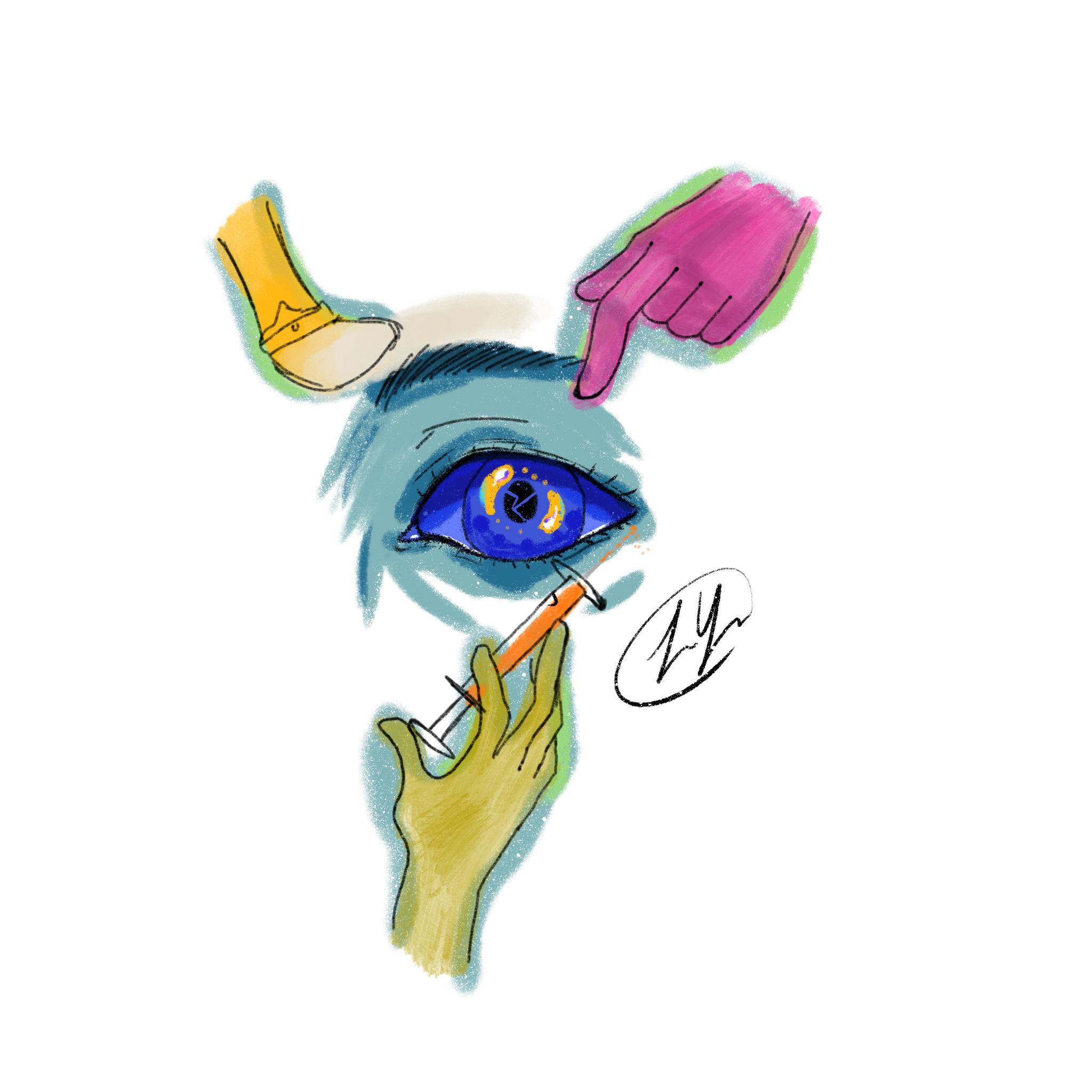
“You always want something you can’t have, and then that will lead you to comparing yourself to social media.
- Jaeda Villasenor ’26
By Ishaan Gupta ’26
The FDA (Food and Drug Administration) announced the ban of red dye no. 3 this year in food and drug products.
Food products that currently use the dye have until 2027 to modify their ingredients while drug products have until 2028.
Red dye is prevalent among current products and many wouldn’t think twice about which items contain it.
Products that do contain it include candies, frosting, Popsicles, strawberry milk, certain sodas and drinks, cough syrups, and coated tablets.
AP Environmental Science teacher Michael O’Brien said, “In a general sense, it is red dye that is typically associated with carcinogens.”
According to the FDA, high amounts of red dye have led to cancer in male lab rats. Despite this, no actual evidence has linked the dye to causing cancer in humans.

The Delany Clause, which was enacted in 1958, requires food or color additives to be banned if it is shown to cause cancer in humans or animals. Because of this, red dye no. 3 is facing this ban.
O’Brien said, “I think we should heed the warning.” He continued,
“You’d have to outweigh the benefits of the dye and . . . to human health.”
Other synthetic dyes have shown to have harmful effects and have caused behavioral issues like hyperactivity, inattentiveness, and restlessness in children.
Edison Lew ’26, a student in the BioMed Program, said, “I think the ban of red dye is important because it can represent a domino that pushes for healthier and natural alternatives.”
Despite the link to cancer being seen in rodents who consume red dye, major concerns shouldn’t be ignored due to the lack of evidence in regards to humans.
To combat this, consumers should be aware and choose healthier options, as companies offer alternatives that are made from products such as beetroot, sweet potato, and more.
“I think the ban of red dye is important because it can represent a domino that pushes for healthier and natural alternatives.
-Edison Lew ’26
By Josh Lee ’26
Archbishop Riordan High School’s science department just got an upgrade with its recently established Honors Chemistry class. With this new addition, the course has been able to address two crucial challenges the school has faced academically.
“We needed one,” claimed Dr. Caroline Gochoco-Tsuyuki, the course instructor. “We had to establish an honors-level class for two things: to take care of new students coming with strong science backgrounds, and to make the leap to AP Chemistry a lot easier.”
Equipped with a passionate teacher and a schedule packed with intriguing areas of study, Honors Chemistry seems to have many benefits for enrolled students.
“It has definitely been very helpful to me because I’ve always really liked science,” said Greta Wang ’28. “This class has allowed me to expand my knowledge of science and do cool experiments that I wouldn’t normally do.” Honors Chemistry filtrates past the basic material, producing a compound of knowledge that reaches up to material taught in university-level classes.
“We are learning everything,” said instructor Gochoco-Tsuyuki. “Starting from atoms and then building up to chemical equations, stoichiometry, gasses, thermodynamics, acids and bases, and chemical equilibrium in one semester.”
It’s a whole different element

compared to the regular course taught at Riordan. One aspect that really highlights the difference is the labs.
“The labs that I’m introducing are introductory college class level for these kids. They really are learning at a higher rate and they love the labs,” said GochocoTsuyuki.
The students in her class can attest to that.
Nathan Cheng ’27 stated, “Doing labs with my peers helps
me know how chemistry works in real life. While at the same time, it builds my collaboration skills and it makes it more engaging to do hands-on labs.”
“We get to use cool tools like Bunsen burners,” added Wang. “It helps me learn a lot better by being able to physically work with what we have been learning about in class.”
With good effort comes great payoffs. Any student taking Honors Chemistry will be
prioritized above other students for AP Chemistry. The class is still in its infancy, but GochocoTsuyuki has plans for the future. “I want to expand this class beyond one block and have it become at least two by next year,” she said. “I would love to see the number of honors classes rise as the number of high achieving kids apply to Riordan. I don’t want to turn anyone away who has the ability and is willing to take on the challenge.”
By Miguel Cardenas ’27
Humans try to control time as much as possible with varying levels of success. We may find ourselves very often running late or on the cusp of a deadline while others seem to have it all figured out. These differences are what make up your time personality.
Coined by anthropologist Edward T. Hall in the 1950s, there are two types of time personalities: monochronic and polychronic.
Monochronic individuals like to do one thing at a time and in an orderly fashion. They stick to schedules, deadlines, and set engagements. These types of people usually get anxious and possibly frustrated when sudden changes come into fruition. Regardless, this mindset has them focused and organized with a full focus on the task at hand.
Brian Kosewic ’16, English teacher, said, “Organization is very important. Once I get something I have to do, I put it into my calendar and see how I am going to complete it.”
On the other hand, polychronic individuals tend to take on a

Time is difficult to manage, so decide what works for your time personality.
myriad of tasks at once and are not impaired by unexpected changes. They rather focus on flexibility to achieve multiple goals.
This heavily contrasts with
monochronic people and feels chaotic. However, to polychronic people, it helps with their mood and energy.
“If I get stuck on a section,
moving onto another task that requires less thinking allows me to autopilot on the easier task while taking the time to reflect and think about the problem in the first task,” said Edison Lew ’26. “Then, I can shift back when needed instead of doing nothing in a dead period.”
But it’s not always smooth sailing, as student-athletes are always juggling time.
Rower and cross country runner Sidney Hansen ’27 stated, “A main struggle is a lack of sleep with all the early mornings, but it is important to make time and take advantage of open blocks amongst other things.”
Understanding these differences can greatly improve how people work and interact with others. That’s why it is important to find a balance as neither is right or wrong; they are just different ways of perceiving time.
So the next time you clash with someone about how they handle their time, remember to be patient, and instead try understanding that it’s not intentional, it’s part of their personality.
By Vincy Huang ’27
Issues for all modes of transportation on Alemany Boulevard and Brotherhood Way have been a concern for neighborhood residents and city officials alike.
Stella Wong, a frequent driver of both streets, stated, “There’s a good amount of traffic along Alemany, and a large amount under the bridge on Brotherhood Way.”
At the latest meeting conducted regarding this issue, three proposals were introduced by the San Francisco County Transportation Authority (SFCTA). As stated on the SFCTA website, “The Brotherhood Way Safety and Circulation Plan will develop near- and long-term alternatives to improve safety, circulation, and connectivity for people driving, walking, and rolling through the Brotherhood Way and Alemany Boulevard.”
Proposal A builds a pedestrian bridge over Brotherhood Way and St. Charles Avenue and raises an intersection at Alemany and St. Charles Avenue. This proposal improves traffic, but does not
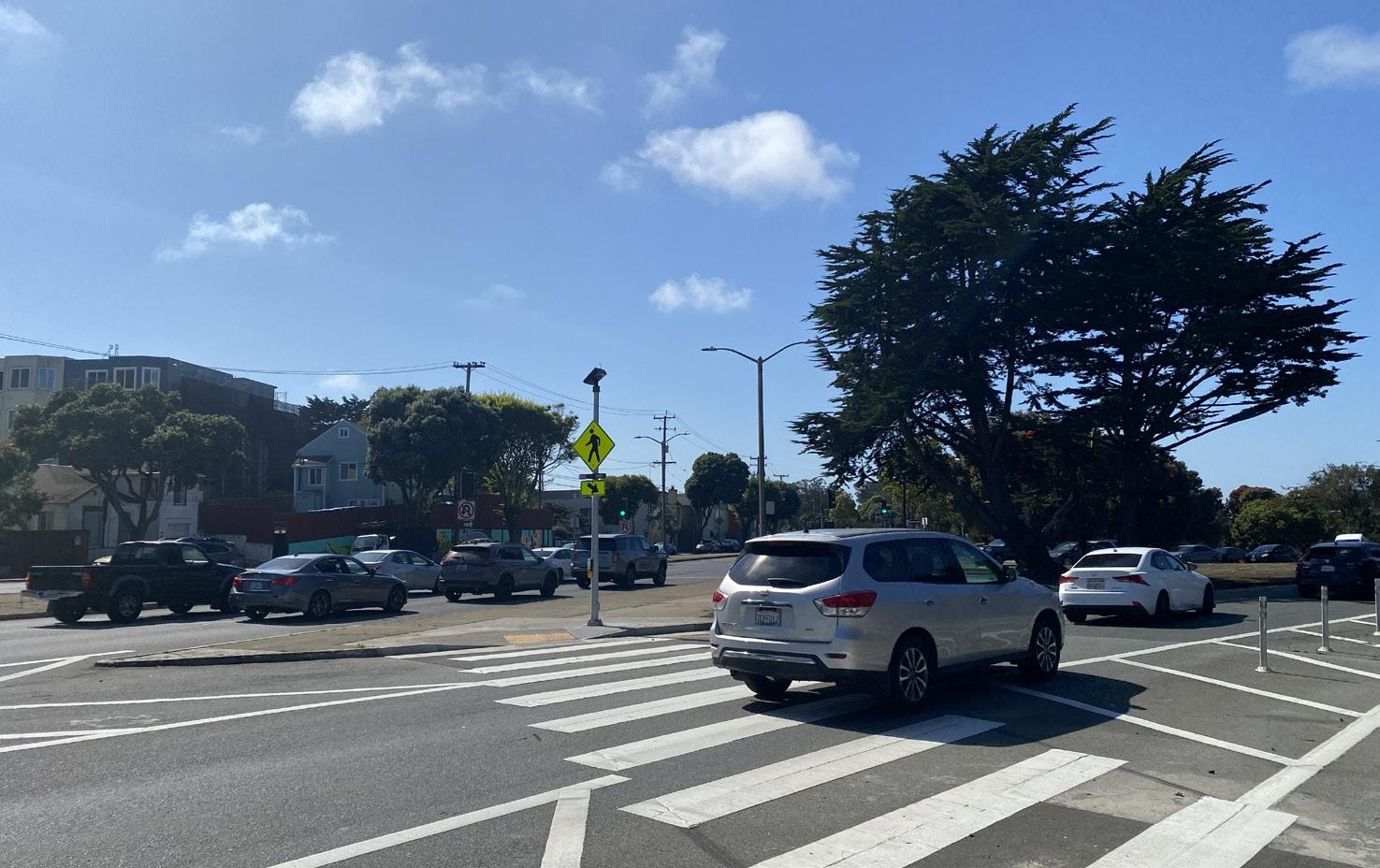
address walking and cycling safety along Brotherhood Way.
Proposal B adds a roundabout at Alemany Boulevard and St. Charles Avenue while condensing intersections at Brotherhood Way and Alemany. This proposal improves safety for walking and biking and reduces vehicle traffic, but increases drivers’ travel time. The aforementioned proposals would cost $25-30 million and would take four to five years to
complete.
Unlike Proposals A and B, Proposal C drastically changes the landscape of the neighborhood by resurfacing Stanley Creek, which is currently buried by cement roads and modern infrastructure. It also turns Alemany into a neighborhood street and relocates Brotherhood Way southwards to increase open space.
This proposal improves pedestrian and cyclist safety
while providing open space for nature and resurfacing Stanley Creek, bringing one forgotten part of nature back into the daylight.
The major downside of Proposal C would be an increase in travel time for drivers during peak traffic hours. It would also cost more than Proposals A and B, sitting at $40-70 million while taking five to eight years to complete.
These proposals garnered mixed reactions from many in the community.
Neighborhood resident Emily Daniels ’27 remarked, “I think that proposal C would be the best option for Brotherhood Way. Although it would take more time and money to complete the task, it seems like the most beneficial opinion.”
Amanda Zhao, a frequenter of Brotherhood Way, stated, “I like Proposal B the best. I bike often so improving cycling safety would be great.”
No matter which proposal the city decides to implement, officials hope it ensures Brotherhood Way’s streets transform into a safer place for drivers, bicyclists, and pedestrians alike.
By Natalia Sanchez ’26
Scientists have reported that over 20 deceased whales have been washing up on the shores of beaches sprawled around the Bay Area from April to July, the newest sighting being July 20.
Their large, lumpy bodies laying out on the sand of local beaches make them hard to miss. They are a sad, smelly sight to see, becoming more and more common throughout the past months.
From vessel strikes to environmental issues, these whales have faced a multitude of obstacles leading to their demise.
Scientist Shalina Peterson from the California Academy of Sciences explained that they were able to necropsy 12 different whales. Of those 12, nine whales showed either sharp or blunt force trauma, which is consistent with vessel interaction or strikes.
In other words, boats on the water have been reckless, crashing into and leaving a devastating impact on the many whale species that inhabit the bay waters.
Peterson added that other environmental issues are contributing to the increase of whale deaths. Disruptions in the food web lead to the whales swimming into higher risk areas for their nutritional sources. Science teacher and environment club moderator Julia StrickerBalistreri stated, “Some migration patterns regarding these whales have changed and we need to be aware of the change needed to fix

this issue.”
Fortunately, humans can help protect these whales and their environment. Humans are their leading source of destruction, but are also the ones who can restore their populations.
Scientists at the California Academy of Sciences are working diligently to help save these whales to prevent the death count from rising.
“I’m hopeful that next year we will find ways to work with the commercial vessels and the shipping and tanker vessel companies that kind of come through San Francisco Bay,” said Peterson.
Isabella Miraglia ’26 remarked, “I think it’s hard to say how we can inform others when this has been happening for decades, but not many people seem to be listening.”
Being positive is difficult, but communities doing their part can make a big difference.
“There’s a lot of things people can do, but I think the most important thing is to educate yourself and find organizations that are putting in the time and energy to learn about the problems wildlife is facing,” said Peterson.
If the community collectively completes simple tasks, it would
make a huge impact on the state of the planet. Staying positive and preserving the environment is key to restoring the wildlife in communities around the world. Peterson said, “Things are challenging, but I’m hopeful.”
Editor’s Note: From the California Academy of Sciences, “All marine mammal stranding activities are conducted under authorization by the National Marine Fisheries Service through a Stranding Agreement issued to the California Academy of Sciences and the Marine Mammal Health and Stranding Response Program. Permit No. 24359.”
By Emmanuelle Ng ’26
Marketing masterpiece or mistake? Sydney Sweeney’s latest collaboration with retailer American Eagle has been a timely topic within the world of pop culture.
Sweeney, an American actress known for her role in the TV show Euphoria, has partnered with American Eagle jeans. However, the campaign has gained global traction because of its questionable meanings.
The highly debated-over ad begins with a close-up of Sweeney zipping her jeans, then, in a sultry manner, whispering: “Genes are passed down from parents to offspring, often determining traits like hair color, personality, and even eye color. My genes (jeans) are blue.”
Some observers claim the ad promotes eugenics, the selection of certain traits over others, proposing that Sweeney’s blue eyes, white skin, and blonde hair are preferable and better functioning.
Others see the ad as overly sexualized and aimed towards the male gaze despite marketing women’s jeans.
Additional speculators disagree with the ad intending to promote eugenics, but do understand how it may be interpreted. Social Science teacher Grace Ingersoll commented, “It’s always important for brands to be sensitive of and
understand how they can be perceived, and I understand how those words can be perceived as a form of eugenics.”
Opinions from the opposing side believe that the backlash is forced and overdramatic. University of Waterloo student Bennett Leung said the “controversy was overdone…the ad doesn’t promote eugenics, but instead uses Sydney’s features as a marketing strategy.”
The ad has reached a multitude of people, even receiving comments from President Donald Trump, who posted on social media that Sweeney’s ad is the “HOTTEST” ad out there. After the President’s comment, American Eagle’s stock prices rose 25 percent.
On the same topic of denim collaborations, retailer Gap has partnered with girl group KATSEYE, releasing an ad featuring the members dancing to Kelis’s “Milkshake” while fitted head-to-toe in denim.
KATSEYE is known for being a global group with each member being from a different culture and ethnicity. The group is famous for their viral hits such as “Gnarly” and “Touch.”
Some believe Gap planned the ad after the Sweeney controversy, while others think it was simply a matter of impeccable timing. Nevertheless, viewers have declared a denim war between American Eagle and Gap.

In October, KATSEYE and Gap’s “Better in Denim” ad already has over 38 million views on YouTube. The ad has also gone viral on social media, with users filming themselves doing the dance.
Darwin Hernandez ’26, who has seen the ad around 20 times, believes Gap focused better on actual jeans than American Eagle, expanding on how the ad “shows the girls performing and
dancing in the clothes, showing the viewers ‘look what people can do in our jeans’.”
Amidst the denim dilemma, American Eagle has commented that “Sydney Sweeney is worth every single dollar we invested.” Gap has not commented on American Eagle’s campaign, leaving the intentions of both ads in terms of each other solely up to the viewers’ interpretations.
By Logan Tuman ’26
Beep Baseball, a baseball adjacent sport, has become very popular among the visually impaired and blind.
The National Beep Baseball Association or NBBA was started in 1976 in Chicago, Illinois by “The Dirty Dozen,” but was recently founded by Peter Cancro, the CEO of Jersey Mikes. This game helps include visually impaired people in the sport everyone loves, baseball.
According to president Richie Flores, “In 1964, a beeping softball was developed by Charlie Fairbanks of the Telephone Pioneer Service Organization, for blind children at the Colorado School for the Blind to have a catch with their teachers and friends.”
The rules of the game are: everyone must be blindfolded to even the playing field. They use a 16 inch softball with a beeping mechanism so the players can hear when the ball is near them. They use a pylon with a buzzer inside so they know where to run. If a player touches the pylon, that team scores a run.
Lastly, the pitcher and the batter are on the same team and try to give up a hit.
Riordan Varsity baseball coach

with
“Everyone should be able to play sports. It’s important that there are these opportunities so people with disabilities can play.
- Mason Cohn ’26
Craig Sargent said, “I think it’s incredibly important for sports programs to intentionally create opportunities for athletes with disabilities. Sports aren’t just about competition—they’re about teamwork, confidence, joy, and community.”
He added, “By making sure there’s space for everyone, we give all athletes a chance to grow, belong, and experience those benefits.”
Baseball is an important sport for so many people; it brings joy and happiness to most everyone who watches or plays the game. So, there is no reason why it can’t do the same for people with disabilities.
Four year varsity baseball player Mason Cohn ’26 said, “Everyone should be able to play sports. It’s important that there are these opportunities so people with disabilities can play.”
Being able to belong to a community such as Beep Ball, where people share the same struggles as each other and understand what everyone is going through, helps them find a sense of belonging and purpose. This sport brings people together all across the United States for competition and fun.
By Isabelle Abad ’26
Every high school student will most likely say that they spend too much time on social media. Hours pass with no one noticing, thanks to popular TikTok dances, Instagram reels, and late-night Snapchat streaks. What starts as “just five more minutes” can easily become a lost evening.
For this reason, social media limitation has been gaining popularity. Some students have begun to time how long they spend scrolling, switch off their phones at night, or even place them in a different room while they study.
These small routines don’t completely eliminate social media from people’s lives, but they can help to reduce the amount of time individuals spend scrolling aimlessly on social media.
“I use social media regularly and sometimes it can distract me while I’m doing my homework or keep me up a little later at night,” said Chloe De Castro ’26, describing how the behavior affects her sleep and academic performance.
Setting boundaries can be a game-changer for some students, allowing them to focus better on their assignments or get more
sleep. Others may find it tedious or too simple to overlook. Are these constraints merely another notification to swipe away or do they actually have an impact?
“Personally, I don’t think they’re extremely effective because I always swipe away,” De Castro admitted. “But there are times where the reminders help me realize that it’s time to get off social media.”
School counselor David Canales ’02 gave a different perspective, offering an alternative viewpoint:
“I personally use the time limit feature on Instagram to notify me when I approach 30 minutes of usage in a given day. Setting personal boundaries displays a skill set of self-control, which can only benefit a person.”
The argument begs the more important question: can technology actually assist in resolving the issue it caused? While some contend that setting time restrictions increases awareness, others counter that true self control must originate with the individual rather than the app.
“Social media can be a really big distraction for me. I tend to procrastinate on finishing a big


assignment like an essay or project because all I’d wanna do when I get home from a long day of school and football practice is just to rest and scroll through Instagram or TikToks,” said Owee Angeles ’26.
“It’s a really bad habit and it’s caused me to lose sleep some school nights because I just couldn’t stay off my phone,” he added.
The struggle between the real world and a screen isn’t going
away anytime soon as kids juggle their athletics, jobs, and school. Perhaps establishing a balance that works is the answer rather than completely banning social media or implementing rigid restrictions. Nevertheless, the answer may vary from person to person.
Ultimately, the real challenge isn’t just restricting screen time, but it’s deciding what to make time for instead.





By Isaiah Sanchez ’26
Tommy Tofi ’26, offensive lineman for Riordan football, is ranked among the top high school football players in the country.
Tofi is currently ranked as the 122nd overall high school football player in the class of 2026 by ESPN and the 5th-best interior offensive lineman in his class by 247Sports.
According to the San Francisco Chronicle, he is ranked 1st on their annual watchlist of the best high school football players in the Bay Area.
Tofi is committed to playing Division 1 football at the University of Oregon next season, but before committing, he entertained offers from 30 schools, including Ohio State, Ole Miss, and BYU.
Despite his national ranking and recruitment, Tofi expressed, “It comes with huge expectations and pressure from a lot of coaches and people watching.”
Originally a basketball player like his father, Tofi switched his focus to football in the seventh grade after his uncle saw his potential.
When he first started, Tofi explained, “I didn’t play that well, but the more I learned, the better I got.”
Tofi started playing high school football at Sheldon High School in Sacramento and this is where he
realized that he had the potential to do great things.
“I realized I could do something for not only my family, but for future generations in my bloodline. After receiving my first offer and getting All-American, this made me realize I could do something great,” Tofi stated.
He continued to work hard, dedicating his life to football, and this came with new opportunities. After his freshman year, Tofi got the chance to come to Riordan to play football.
Head coach of Riordan football, Adhir Ravipati, said, “He came to us as a very talented sophomore, but he continues to have a great work ethic and be a leader for the team.”
At Riordan, he has excelled as a dominant player on an ambitious team, hungry for success.
Over the past three seasons, he has played a huge role in Riordan’s rise as one of the top football programs in the Bay Area.
Teammate Daniel Saelee ’26 stated, “I see him put in the work and the mindset he has makes all of us work harder.”
Through all the rankings and recruitment, Tofi remains humble and optimistic for his future in football.
He said, “My main goal is to play in the NFL and make my family proud.”

“My main goal is to play in the NFL and make my family proud.
-Tommy Tofi ’26
Offensive Lineman for Riordan football

By Jared Pangalangan ’28
After years of waiting, the Bay Area’s wish has finally come true. The newest WNBA expansion team, the Golden State Valkyries, made its way to San Francisco at last.
On Oct. 5, 2023, the team was officially announced and eventually began playing their debut season later in 2025.
In just their very first season, the Valkyries reached great heights and surpassed many expectations. They made WNBA history as the first expansion team to make the playoffs while also securing the most wins in their inaugural season with 23 victories under head coach Natalie Nakase, 2025 WNBA Coach of the Year.
Lour Shqair ’28 said, “The Bay was long overdue for a WNBA team. Since 2022, the Warriors definitely have brought a bigger name to themselves, so why not share that same attention with women. I’m intrigued to see how they make a name for themselves.”
The Valkyries are more than just a team, but rather a movement that has created excitement
amongst a strong community in the Bay Area. Fans from all over came out to support their newest team and sold out each of their 22 home games at Chase Center, commonly known as “Ballhalla” to their supporters. This is a reference to the Valhalla of Norse mythology, meaning the resting place of warriors.
Correspondingly, the Valkyries are named after female figures who guide fallen warriors to Valhalla. This creates a sense of strength for fans and an intense environment for home games. They have made a huge impact on the youth and connects the community in unique ways.
Mikey Ordona Jr. ’27 stated, “The Golden State Valkyries have impacted their community by inspiring people, especially young women who want to take their passion to the next level. Watching the Valkyries helps bring fans together and motivates them.”
With the conclusion of this year’s season, Valkyries fans remain optimistic for the next season as the team looks to build off their successful inaugural campaign.
By Sara Noguera ’27
As the sailing preseason gets underway, the team is already hard at work sharpening their skills and setting ambitious goals for the months ahead. Practices not only focus on handling the boats and adjusting to unpredictable wind conditions, but also on strengthening communication and trust within the crew, two elements that can make or break a race.
Success in sailing is rarely about one sailor’s ability alone; it depends on the team’s ability to respond quickly to sudden shifts in weather, currents, and competitors’ tactics. With greater success comes greater goals as well.
“For me, the biggest goal this season is for our team to move up in the state rankings,” said Kaia Burris ’27.
Competing in regattas against schools with top programs who field highly experienced sailors is challenging.
Still, Burris remains optimistic. “We sail against schools from all over California, and the competition is definitely pretty tough, but I think we’re in a good place to take that next step,” she added, highlighting the team’s steady progress over the past year.
That progress comes from rigorous preparation. According to Nolan Balocki ’27, the team trains multiple times a week to

stay sharp.
“Two practices a week with occasional team meetings and focused practices,” Balocki explained. A typical practice day requires full commitment, often stretching long past the school day. “Pack bag, get to school, school ends, drive to StFYC, rig boats, sail, de-rig, shower, drive home, homework, go to bed,” he said, capturing the demanding rhythm of a sailor’s routine.
The St. Francis Yacht Club (StFYC), where the team trains, provides direct exposure to the challenging waters of San Francisco Bay conditions that test
both skill and endurance.
For Balocki, the goals this year are ambitious, but within reach.
“Personal goal: get top three at most State Championships regattas,” he said.
The team is striving for consistent top-five finishes, with particular attention on the Rose Bowl Regatta, one of the most prestigious high school sailing competitions in the country.
“I’m excited for the Rose Bowl regatta as it is always competitive and the last one I got top five with my partner,” Balocki shared.
Beyond results, sailing offers valuable lessons about resilience and adaptability. Balocki said, “Always have a plan B. Try one thing, and if it doesn’t work you can always bail.”
In a sport where wind shifts in seconds and strategies change just as fast, the ability to adjust can be the difference between victory and defeat.
By Robert Bennett ’27
Riordan’s cross country team has spent the fall pushing limits, setting personal bests, and building momentum through every meet. From early practices to league competitions, the team’s mix of veterans and newcomers has made this season one of steady progress and strong spirit.
Head Coach Benny Willers ’08 described the team’s performance as “steady! Everyone has improved and we have seen a lot of growth throughout all levels. Freshmen are getting the hang of the sport, and the veterans are getting more and more competitive within their levels.”
One major highlight came at the Ram Invitational at Westmoor High School. “It really showed how competitive our Girls Varsity team can be this season when fully healthy,” Willers said. Despite injuries that set back the varsity squads, he noted that learning to manage those challenges “will be key to our success come championship season.”
Coach Brian Kosewic ’16, who works closely with freshman and rookie runners, highlighted the team’s strong start at the Lowell
With teamwork, preparation, and dedication, the sailors are determined to continue improving and make this year their strongest yet. Invitational.
“Our Women’s Varsity finished second out of 17 teams, and our Men’s Junior Varsity finished second out of 22 teams. Those performances kicked off the season with a bang.”
He added that the younger athletes are impressive.
“Diego Stagnaro ’29 has placed 3rd in both WCAL freshman boys races so far, and Zina Jones ’29 just placed top 10 in the most recent WCAL freshman girls race.”
Runner Sean Dowd ’27 described the season as “very good, especially the first two races,” calling the Lowell Invitational “very memorable” after Riordan placed second as a school. He praised the team’s unity, saying, “It comes from showing up to all the practices and cheering each other on at meets or even during workouts on the track.”
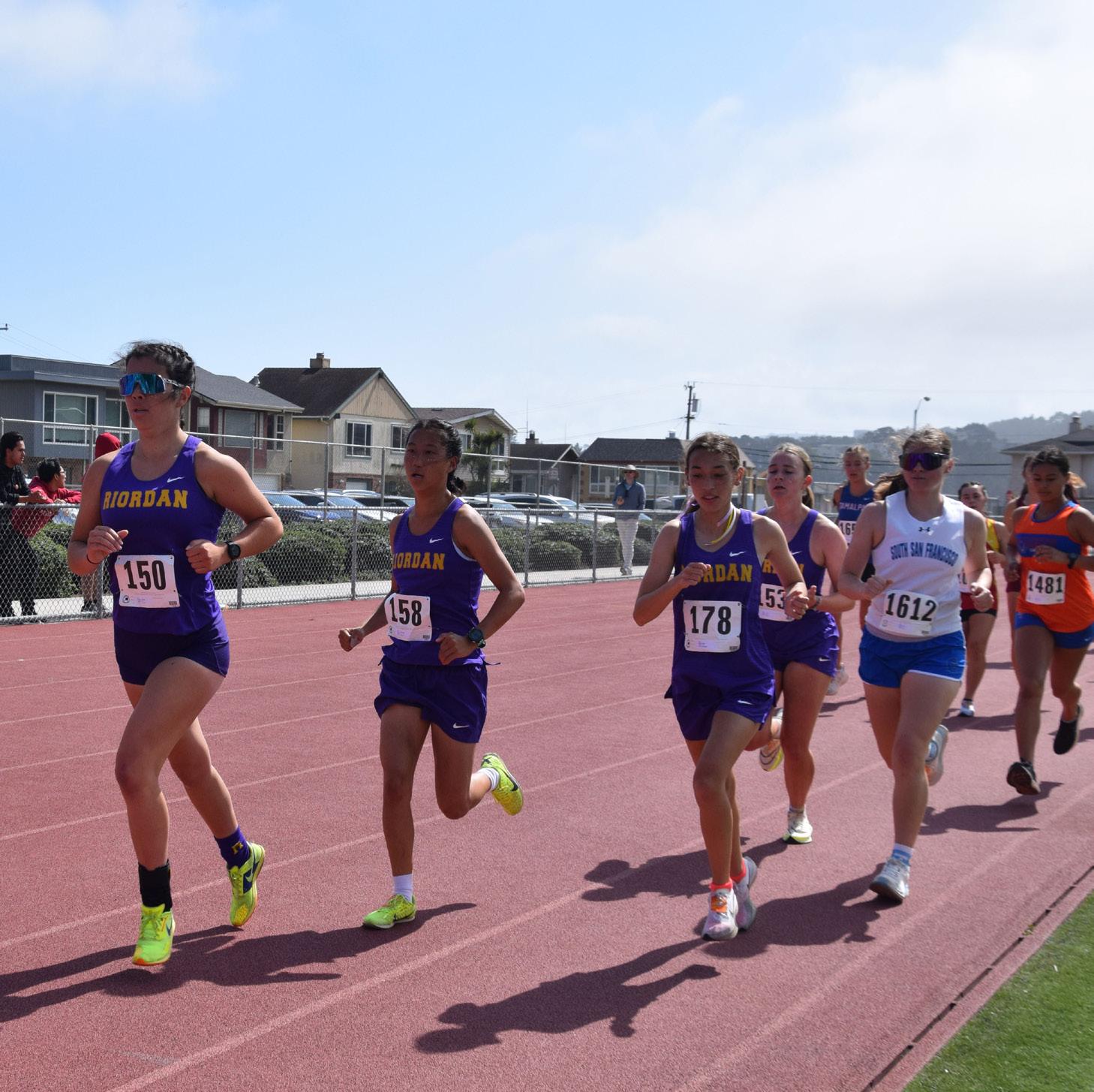
As the postseason approaches, Kosewic expects the team to keep up its momentum. “Our varsity teams – especially the Varsity Women – are going to continue to get even more locked in and competitive as they look to make a run to qualify for the state championship.”
With steady progress and strong leadership,
By Keira Wallace ’26
This year, marked a historic moment for Riordan Girls Golf. The 13-member team has officially become the first varsity girls golf team in all of Riordan history.
Girls Golf has already competed in several matches this season and has made huge strides towards improving the individual and team strength and attitude.
As a no-cut team this year, the main focus of the season will be to welcome beginners and improve their overall confidence and skill in the sport.
Returning coach Abe Paranal ’95 wants his team to not just focus on winning, but also acknowledge the immense amount of integrity and respect that is necessary for golf.
“Golf is not always about hitting your driver straight and far, or making 8-foot putts for birdie. It’s about being a good playing partner by acknowledging other
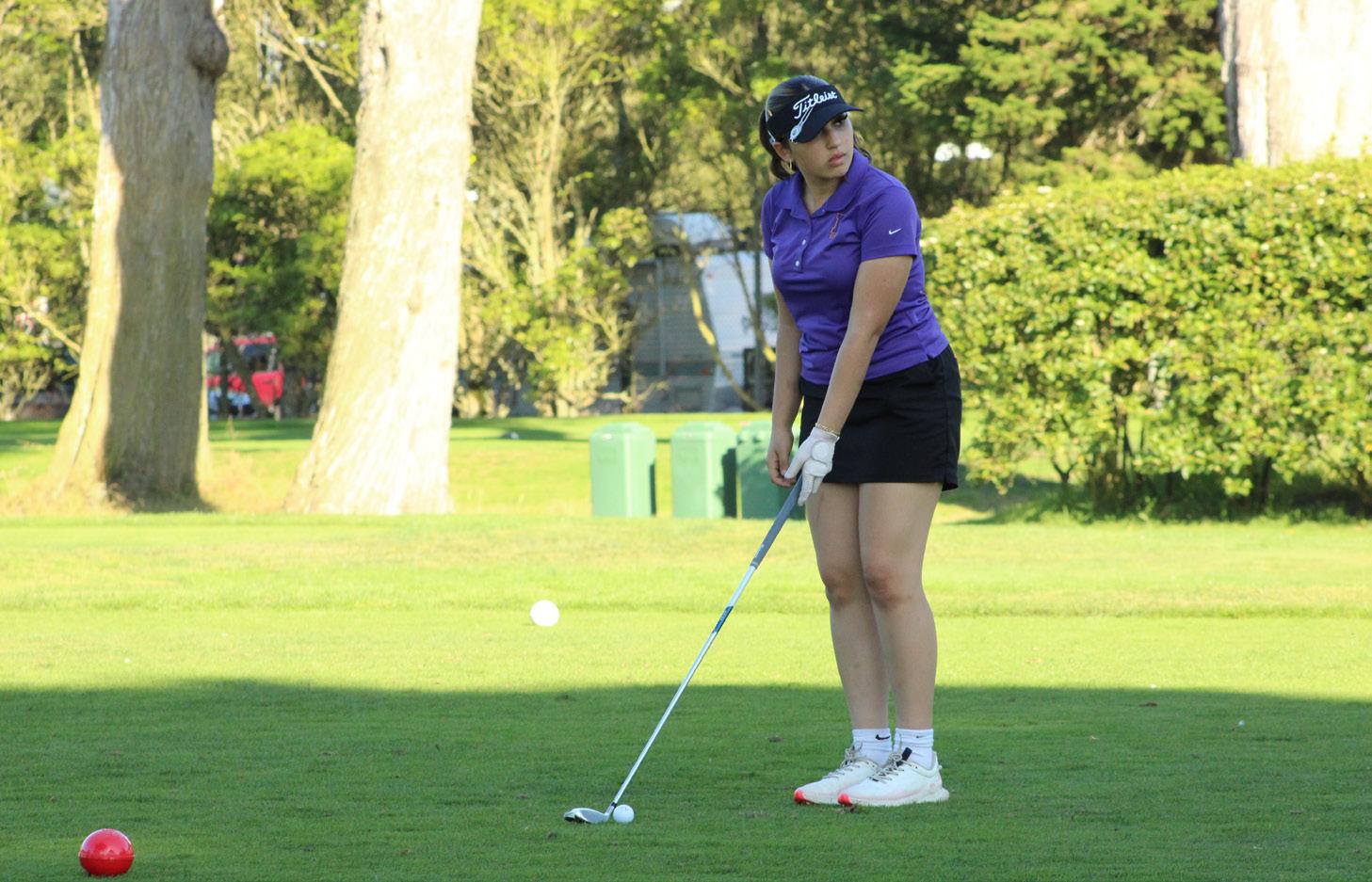
golfers’ good shots and helping them locate their ball when walking down the fairway.”
In addition, the team has competed in an 18-hole Jamboree, which was far less pressure and a better way to grow as a team and connect with other coaches and
golfers. These events provide ways for new members to build confidence.
Players like Olivia Veroy ’27 and Aymberley Hamilton-West ’26 have grown tremendously over the past year and serve as inspiration to these new players.
Veroy has shown improvement by consistently scoring low and even getting her first birdie in the match against St. Francis.
Hamilton-West shows a newfound dedication following her decision to let go of other commitments to focus on golf.
This year, Hamilton-West has shown the necessary leadership that drives the Girls Varsity Golf team. She explained that though it has been a tougher season this year, she is “very proud of the team to be able to hold it together and continue playing. Most of our opponents have been challenging, but nothing a little more practice and dedication can’t fix!”
The bond that has held together this team is an amazing reflection of Riordan’s spirit and the sport of golf. This season has shown true perseverance, and it has clearly taken a lot of work to get to this point.
By Aliyah Pasion ’26
At the start of the fall season, the Riordan girls volleyball team was back on the court, preparing for another competitive season.
After a summer full of preparation, the team had high hopes this season, with a mix of talented transfers and younger players stepping up to varsity.
Goals for the season are more than just winning games. “Our goals for this season are to keep it competitive, stay focused, worry about what we can control on our side of the court, to have lots of lots of energy, and most of all just have fun,” said Tehina Haungatau-Rios ’26.
The first few weeks were marked by challenges in adjusting to new teammates and communication on the court.
Now that they are more familiar, “We now trust each other knowing that someone can do their part and hold each other accountable,” said Tyina Canales ’27.
As the season unfolds, the players are excited and know that their dedication and hard work will pay off. The WCAL matchups are always competitive, and this year, the team hopes its new chemistry will help it stand out. With their confidence, the team is ready to complete the season with even greater success.


By William Saunders
“We’ve
After four years coaching at Archbishop Riordan High School, Raymond Wong retired from the girls tennis team.
Taking his place as the new head coach, Andrew Chueng stated, “I think being the new head coach for the Girls Tennis Varsity team is great and my transition was smooth due to being the JV Girls tennis head coach and Varsity boys tennis head coach last year.”
The new coach has two goals for the rest of the season. One is to continue teaching the players team work skills that will help them on and off the court.
The other goal is simpler. “Obviously winning is always going to be a goal but having fun and leaning into the team culture or chemistry makes winning that much sweeter,” he said.
“The team I am coaching has really come so far since the beginning of the season . . . and that is due to their hard work and dedication to the sport. Please come cheer on the team and Go Crusaders!
-Andrew
Cheung Girls Varsity Tennis Coach
Chueng has been achieving these goals through focusing his training routines around conditioning, footwork, and drills.
By E’moni Ferdinand ’26
As the 2025-2026 school year began, Archbishop Riordan’s football team wasted no time getting back to winning games.
With a 6-0 record–as of press time–statement wins against top tier teams such as Pittsburg High School, and exhilarating wins against rival San Francisco schools, Sacred Heart Cathedral and Saint Ignatius, they’re already off to a great start in hopes of an even greater season.
Key players like Vanderbilt University commit Michael Mitchell ’26 agreed, stating, “The season is going really well so far. We had a really great summer doing practices and tournaments to get tuned up for the season. I’m excited to have the opportunity to play this game I love one last time in high school.”
With many of the players graduating soon, it is their main goal to end their high school careers on a high note, as well as to make memories that they’ll carry on into the future.
“It’s a bittersweet feeling for sure, I’ve built all these bonds and we’ve formed such a great brotherhood over these past few years. But on the other side of that I’m excited to start a new journey and continue forming bonds and brotherhoods at the next level,” stated San Jose State commit Skylar Tiatia ’26.
Though the players are outstanding on the field, for Head

Coach Adhir Ravipati and the rest of the coaching staff, participating in the football program is about growing off the field as well.
Ravipati commented, “We talk about developing our players in three phases: be great leaders in the community, be committed to academics and intellectual curiosity, and be great football players overall. The team has worked hard to build an elite culture, and set us up to have
a potentially historical season, WCAL and CCS open champs, and from there, Norcal and State champions.”
To make it that far, the spirit of Riordan’s student body and the overall community will be key. Their love, appreciation, and passion for the team is shown at each and every game; and suffice to say, each game is without a dull moment.
Zion McGuire ’26 said, “When
I watch my football team, I get so caught up in it. I feel excited and proud regardless of the outcome. Win or lose I remain hopeful for the future.”
For the 2025 season, Riordan’s Football team continues to grow and push each other, hoping to claim an illustrious state championship while simultaneously reflecting pride, purpose, and performance, all core pillars of Riordan’s identity.
By Emilia Ross ’26
New rules raised eyebrows for many flag football players this season as the National Federation of State High School changed the rulebook for the 2025-2026 season.
According to NFHS, the size of the field and the number of players on the field has changed. NFHS states, “In addition to determining one of the three options for the playing field, there are 18 other rules to be determined by state adoption, including the establishment of rules regarding place kicking for field goals and trys (points after touchdowns).”
With these new rules in place this season, many players notice a stark difference between this year and last year in terms of gameplay.
Coach Lee Mauga stated, “The game is more physical now. Girls are allowed to block/screen on offense and for the defense you can rush as many girls as you want, 1 yard from the line of scrimmage. QBs have to make quicker decisions in the pocket
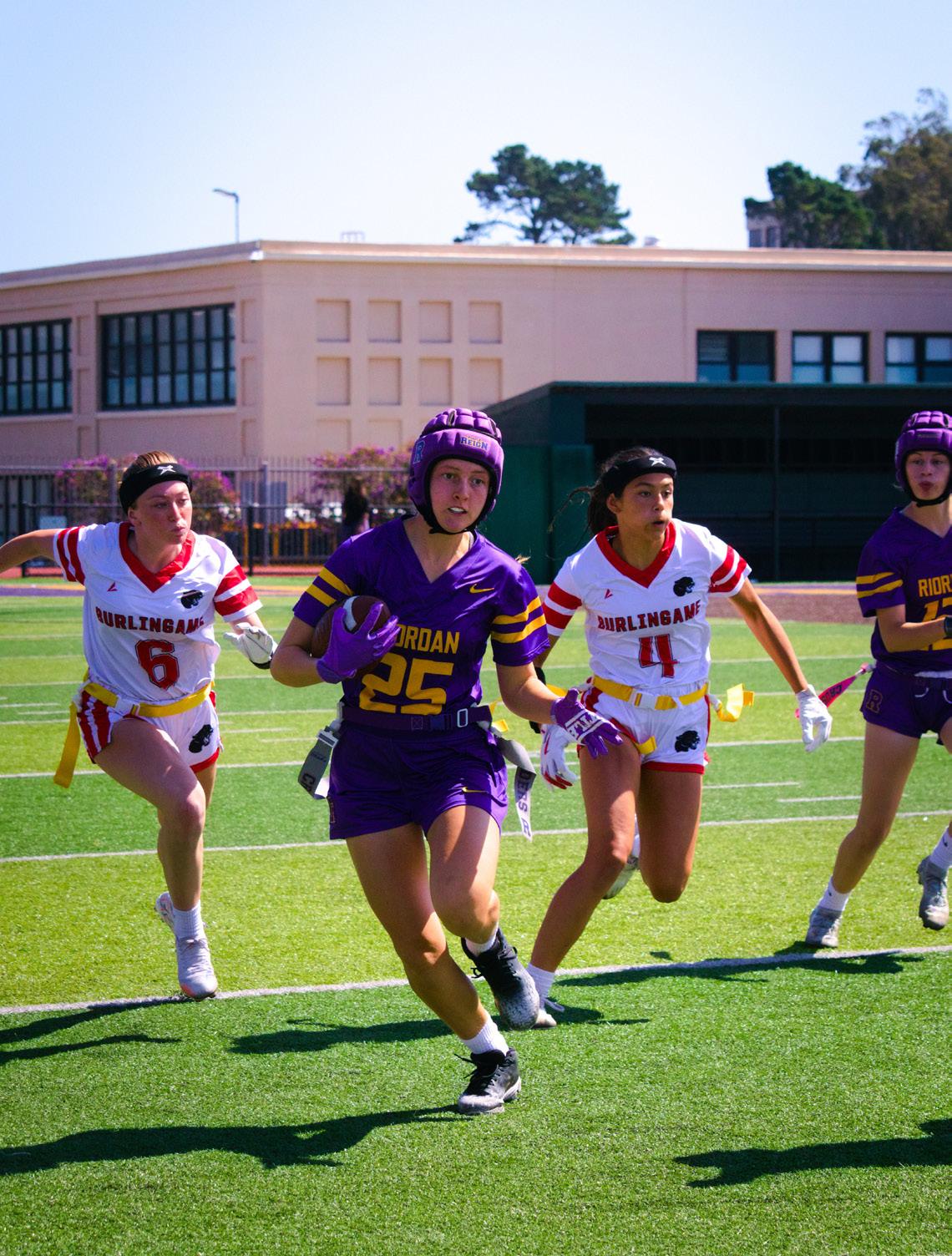
due to pressure of the pass rush.”
Along with this, many have found that the game is more focused on defense than offense. One way that the game has changed in this way is the addition of new kicking rules. With punting added, teams are able to hold the opposing teams closer to the goal.
Carmen Giuffre ’27 pointed out, “The league is definitely different and the teams we’re looking at playing into the season are mainly run teams, which means more reliance on the linebackers and the rush on defensive while contrary with the offense as we’re trying to establish a secure position to try and pass and run the ball a lot this year.”
While the team may have faced an unexpected turn of events over the summer, they made clear that they can handle anything.
Coach Mauga said, “We have adapted pretty quickly to the new rules as a defense and our offense is slowly building up their confidence. I feel like once our offense gets rolling, we are going to be a hard team to beat this year.”
Review and Photo by Loghan Hwang ’27
Nestled across from KFC on Taraval Street lies Dumpling Specialist, an unassuming northern Chinese restaurant serving traditional dishes. As I walked in for breakfast, there was no music playing but a faint chattering filling the restaurant. We were greeted by the server and immediately seated. For our selection of foods we opted for the sweet soy milk, youtiao and sticky rice youtiao.
The first to arrive was the sweet soy milk piping hot, emitting steam from the paper cup it was served in. Wafting up into the air was this creamy nuttiness accompanied by a honey like aroma. By itself, it was not like your ordinary soy milk from Starbucks, this was pure soy milk making it taste clean and smooth with no funky flavors. Next came the youtiao, which is a deep fried dough. It was golden brown and
Dumpling Specialist 1119-1123 Taraval St., San Francisco, CA
made a sound when you rubbed your chopstick on top. Alone, it was extremely crispy but not fried to where it gives you a headache. With the soy milk, it was heaven. Added soy milk made it so the inside was coated with the creamy milk while the outside retained its crunchiness.
Lastly, the sticky rice youtiao arrived: A sticky rice roll filled with fried dough, pork floss and Chinese pickles. The rice was sticky enough to bond together but I was able to feel every grain of rice. Chinese pickles tend to be dry but extremely umami and salty which was neutralized by the sweet pork floss. For texture, a large piece of youtiao was stuck in the middle, bringing the whole dish together: salty, sweet, chewy, and crunchy.
Overall, I would rate this place a 4/5 and would go again. The dishes were simple, yet so comforting.

Review and Photo by Sasha Feliciana-Chan ’26
I had the pleasure of trying this neighborhood staple in my community, the small cafe on 22nd Street called Guiliana’s. This Americana-themed spot is one of many scattered across the Dogpatch area and offers plenty of food items ranging from poached eggs to cheeseburgers.
Naturally, I was called to their signature beignets, a fan favorite among the locals. They came in three flavors: dark chocolate with powdered sugar, cinnamon sugar and just powdered sugar. I ended up ordering one of each.
The chocolate beignet was the richest. The soft chewy dough paired with a gooey chocolate filling oozed out at first bite. A powdered sugar coating and drizzle of chocolate on top only added onto its sweetness.

Review and Photo by Isaiah Mateo ’26
At 1166 Howard Ave. in Burlingame, Mints & Honey solidifies their standing as a popular breakfast destination for those who want to enjoy a unique take on traditional breakfast dishes. The restaurant’s cozy interior was lit up with warm lights and greenery.
Their menu was stacked with their variations of common dishes such as: waffles, toast, sandwiches, and more. They offer sampler options for their waffle and toast section for people who want to experiment. I came to a consensus and ordered their avocado and egg toast and waffle sampler.
come back for.
The waffle sampler was an experience. I was allowed up to four variations, so I tried their Classic, Banana and Cream, Berry and Yogurt, and Churro Waffle. The Classic was sweet and buttery but nothing special. The Banana and Cream was an elevated version of the previous waffle. The addition of bananas and toasted walnuts brought out a taste familiar to an ice-cream sundae.
Giuliana’s Just for You Cafe 728-732 22nd St., San Francisco, CA
The cinnamon sugar had the most balance. Instead of a filling, it was coated with a mix of warm cinnamon and sugar, giving it a cozy, snackable flavor with just enough spice.
Last, but not least, were the powdered sugar beignets. These classics were simple, fluffy, and light. The fresh heat slightly melted the sugar, though they were quite messy covering my hands and hoodie with sugar.
Overall, my favorite was the cinnamon sugar beignet. Its mix of sweetness and spice made it both comforting and easy to enjoy any time. Still, no matter which one you choose, Guiliana’s prove why beignets remain a timeless breakfast item. Overall I give Guiliana’s beignets a 4/5.
Avocado and egg toast is a typical breakfast dish, but how does Mints & Honey’s fare? The avocado presented a refreshing, creamy taste that was complimented by the balanced, sourdough toast. The egg did not offer much aside from a lingering mild yolky-aftertaste. Although I don’t usually order this dish, this would definitely be an item I’d
The Berry and Yogurt was disappointing, with the yogurt flushing out the taste of everything else. Amongst them all, my favorite was the churro. It was similar to the first variation, but their churro sugar and the drizzle of chocolate made it unique.
Mints & Honey offered innovative takes on breakfast dishes while also refining the classics. Overall, I’d rate this restaurant a strong 4/5 and would recommend it if you want to experience creative variations on a traditional breakfast.
